Many people love the contouring powers of memory foam. This material can feel like a soothing, cradling hug when you lie down in bed, and it’s adept at taking pressure off your sensitive joints. The best memory foam mattress will combine the above benefits with features tailored to your individual sleep needs, whether you require a bed that stays comfortably cool or foam that responds well to a certain sleeping position.
Utilizing our extensive experience in the sleep industry, we’ve compiled a list of our favorite memory foam mattresses. Consider your sleep style and browse the beds below to find your memory foam match.
Our Top Pick for the Best Memory Foam Bed
We picked the Nectar mattress as the top foam bed because of its versatile feel, pressure-relieving layers, and affordable price range.
Best Memory Foam Mattresses
- Nectar – Editor’s Pick
- Nolah Signature – Best Memory Foam Mattress for Side Sleepers
- Helix Midnight – Best Hybrid Memory Foam Mattress
- Bear Original – Best Firm Memory Foam Mattress
- Emma Original – Best Cheap Memory Foam Mattress
- GravityLux by WinkBeds – Best Soft Memory Foam Mattress
- Cocoon Chill Memory Foam – Best 10-Inch Memory Foam Mattress
- Nectar Premier Copper – Best Cooling Memory Foam Mattress
- Plank Firm – Best Memory Foam Mattress for a Heavy Person
- Loom & Leaf – Best Memory Foam Mattress for Back Pain
My Video Review of The Best Memory Foam Mattresses

Compare The Best Memory Foam Mattresses
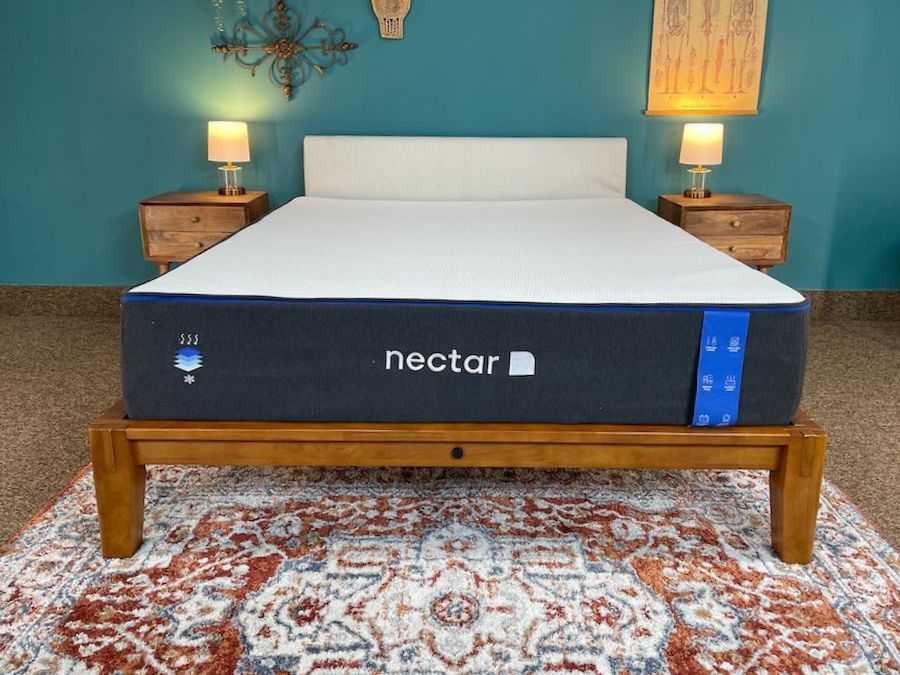
|
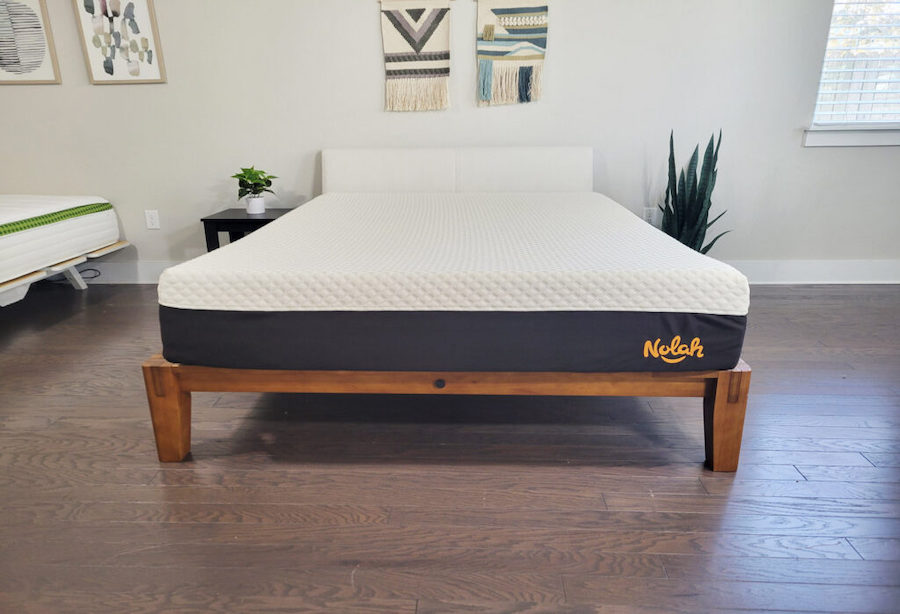
|
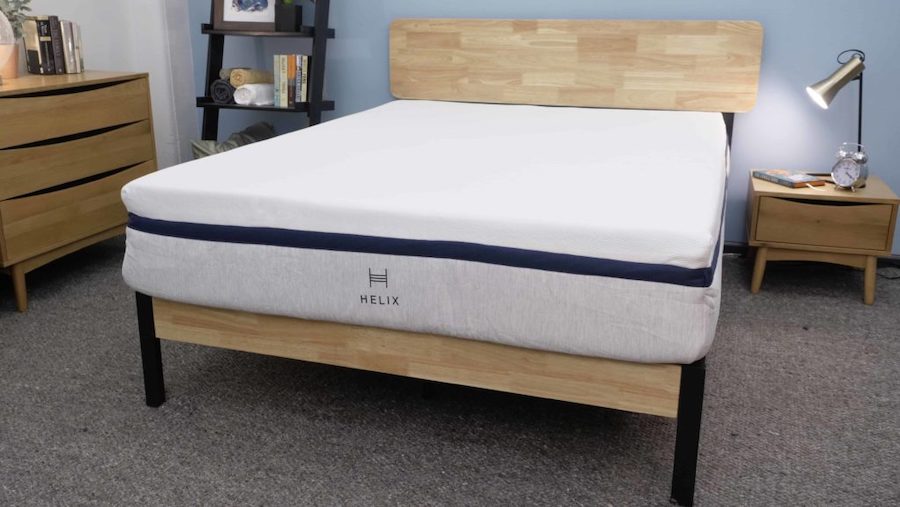
|
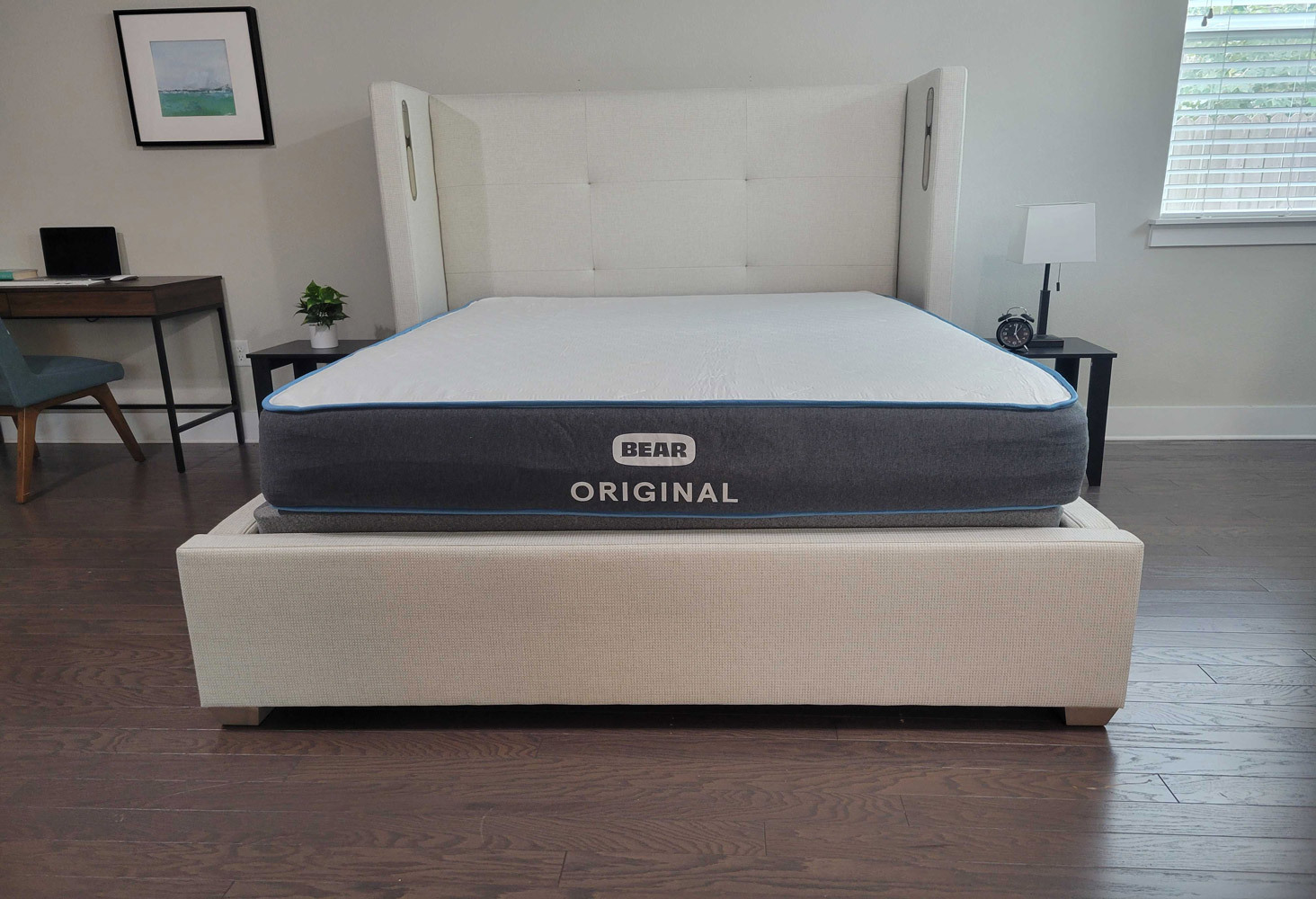
|
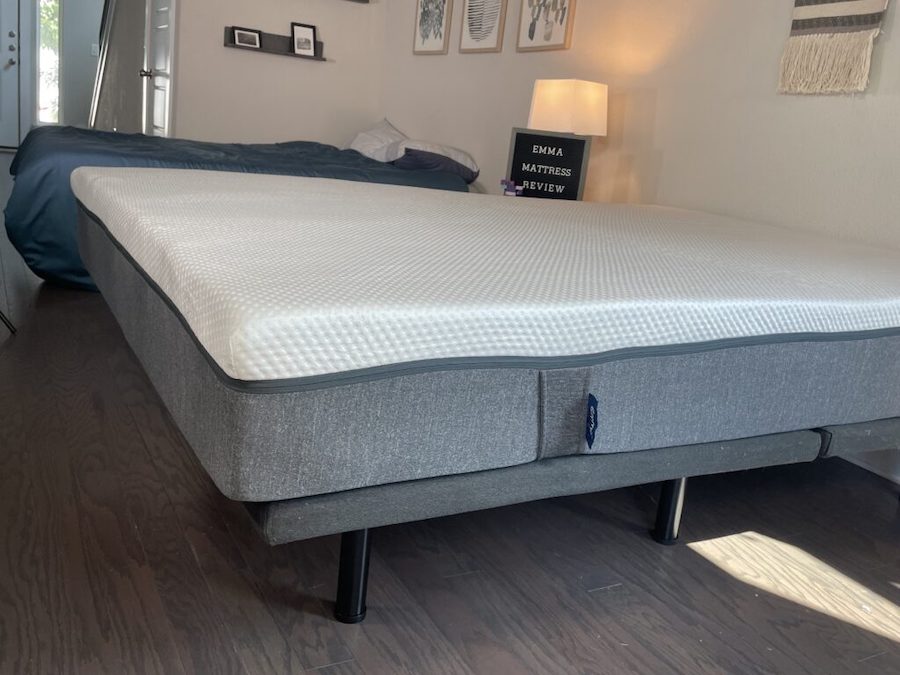
|
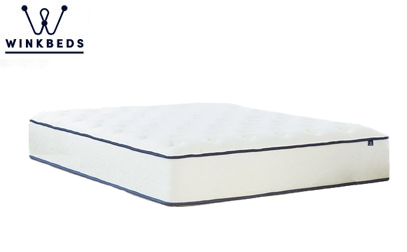
|
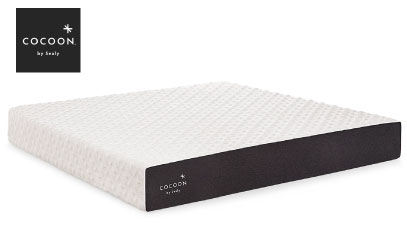
|
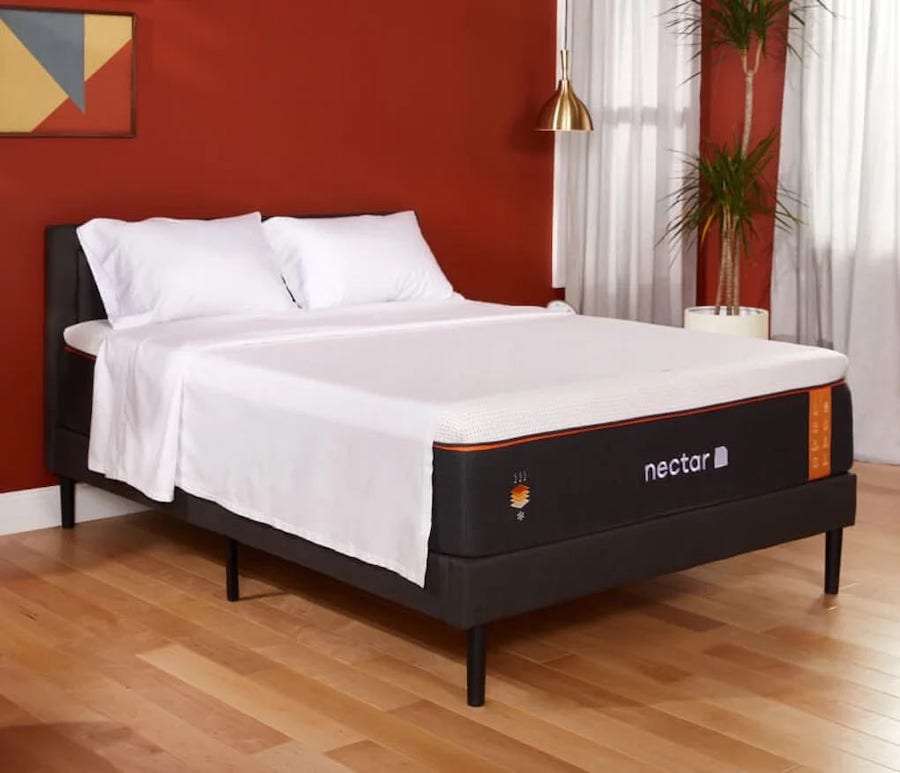
|
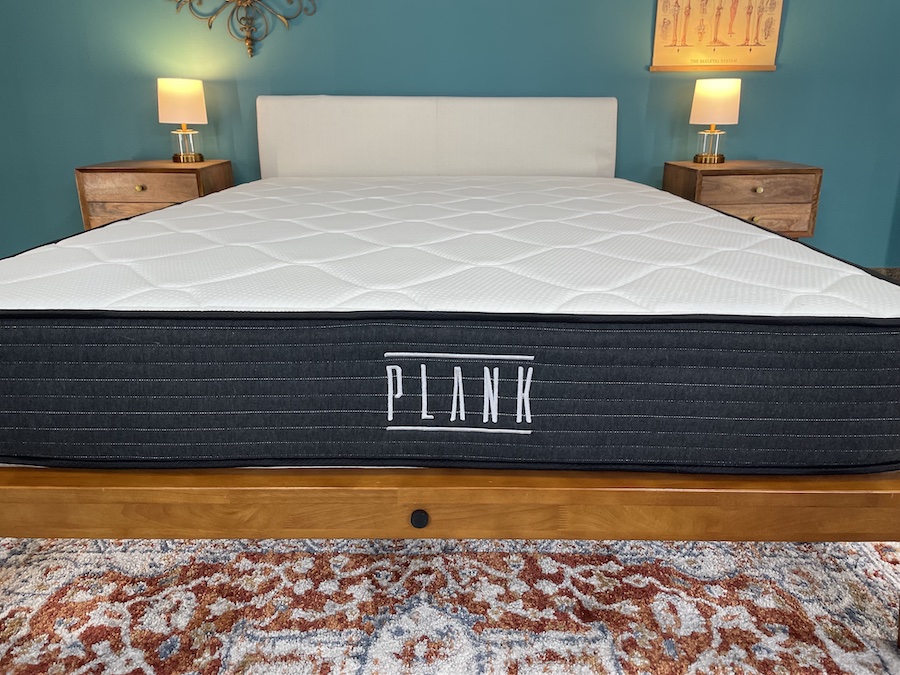
|
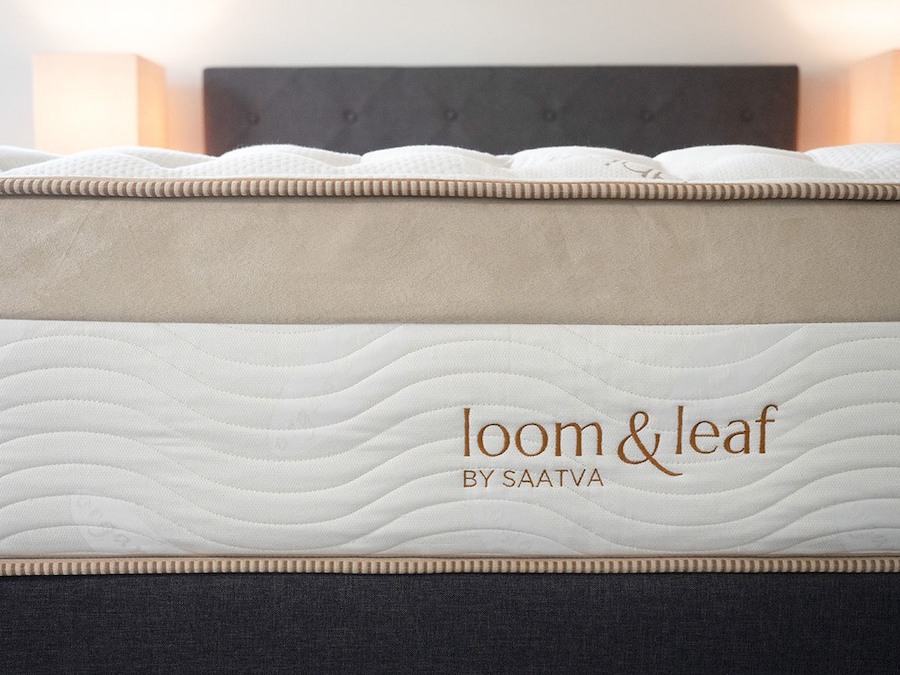
|
|
| Nectar Mattress | Nolah Signature All-Foam Hybrid Mattress | Helix Midnight Mattress | Bear Original Mattress | Emma Mattress | WinkBeds GravityLux Mattress | Cocoon Chill Mattress | Nectar Premier Copper Mattress | Brooklyn Bedding Plank Firm Mattress | Loom & Leaf Mattress | |
| Rating | ||||||||||
| Firmness | Medium-firm: 6.5/10 | Medium: 5/10 | Medium-firm: 6/10 | Medium-firm: 6.5/10 | Medium: 5/10 | Medium-firm: 6/10 | Medium-firm: 6/10 | Medium: 5/10 | Multiple firmness options | Multiple firmness options |
| Material | Foam | Foam | Hybrid | Foam | Foam | Foam | Foam | Foam | Foam | Foam |
| Cooling | — |
|
— |
|
|
|
|
|
— | — |
| Warranty | Lifetime warranty | Lifetime warranty | 10-year warranty | Lifetime warranty | 10-year warranty | Lifetime warranty | 10-year warranty | Lifetime warranty | 10-year warranty | Lifetime warranty |
| Shipping | Free shipping | Free shipping | Free shipping | Free shipping | Free shipping | Free shipping | Free shipping | Free shipping | Free shipping | Free shipping |
| Trial Period | 365 nights | 120 nights | 100 nights | 120 nights | 365 nights | 120 nights | 100 nights | 365 nights | 120 nights | 365 nights |
| Best For | Back Sleepers, Side Sleepers, Hip Pain, Joint Pain | Side Sleepers, Back Sleepers, Hot Sleepers | Couples, Back Sleepers, Side Sleepers | Hot Sleepers, Back Sleepers, Side Sleepers | Hot Sleepers, Kids, Back Sleepers | Back Sleepers, Hot Sleepers | Back Sleepers, Hot Sleepers, Side Sleepers | Side Sleepers, Back Sleepers, Hot Sleepers | Stomach Sleepers, Back Pain | Back Pain, Side Sleepers |
Sleep Advisor’s Testing Methodology
At Sleep Advisor, our mattress reviews are based on findings from in-person tests that allow us to have a genuine understanding of how the mattress feels and performs. We look at features that are valuable to consumers, such as temperature control, bounce, edge support, and motion isolation.
We also evaluate mattress performance for back, side, and stomach sleeping. Lying in different positions lets us know how supportive the bed is and if it’s good at relieving pressure.
We then take all the information we’ve gathered to rate the bed in specific categories. These results allow us to help our readers find the right mattress for their needs.
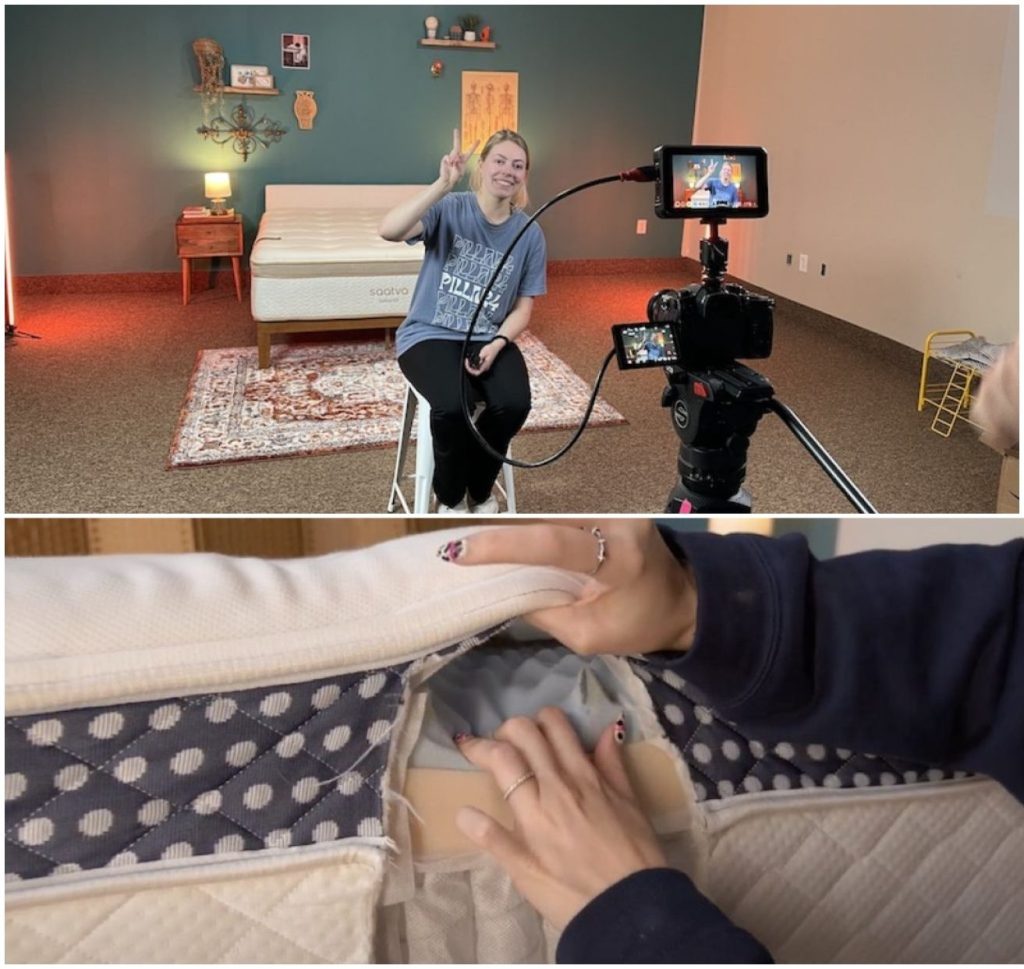
The Best Memory Foam Mattresses, Reviewed
Nectar – Editor’s Pick
Nectar Mattress
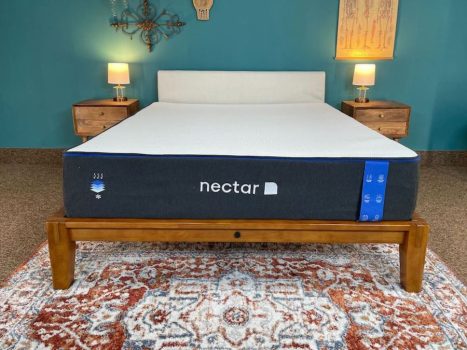
Nectar offers the deeper hug of a traditional memory foam bed but with updated cooling and a Forever warranty.
Material
Foam
Trial Period
365 nights
Shipping Method
Free shipping
Firmness
Medium-firm: 6.5/10
Warranty
Lifetime warranty
Price Range
$$$$$
We recommend this mattress for the following sleeper types:
Joint Pain
This bed is perfect for anyone suffering from joint pain.Hip Pain
This bed is perfect for anyone suffering from hip pain.Back Sleeping
Ideal for lightweight and average weight back sleepers.Side Sleeping
Ideal for lightweight and average weight side sleepers.Financing Options
Financing options are available for this mattress.
Nectar Mattress

Nectar offers the deeper hug of a traditional memory foam bed but with updated cooling and a Forever warranty.
Material
Foam
Warranty
Lifetime warranty
Firmness
Medium-firm: 6.5/10
Shipping Method
Free shipping
Trial Period
365 nights
Price Range
$$$$$
We recommend this mattress for the following sleeper types:
Joint Pain
This bed is perfect for anyone suffering from joint pain.Hip Pain
This bed is perfect for anyone suffering from hip pain.Back Sleeping
Ideal for lightweight and average weight back sleepers.Side Sleeping
Ideal for lightweight and average weight side sleepers.Financing Options
Financing options are available for this mattress.

Nectar Mattress
Nectar offers the deeper hug of a traditional memory foam bed but with updated cooling and a Forever warranty.
Material
Foam
Firmness
Medium-firm: 6.5/10
Trial Period
365 nights
Warranty
Lifetime warranty
Shipping Method
Free shipping
Price Range
$$$$$
We recommend this mattress for the following sleeper types:
Joint Pain
This bed is perfect for anyone suffering from joint pain.Hip Pain
This bed is perfect for anyone suffering from hip pain.Back Sleeping
Ideal for lightweight and average weight back sleepers.Side Sleeping
Ideal for lightweight and average weight side sleepers.Financing Options
Financing options are available for this mattress.
Why the Nectar Earned Best Memory Foam Mattress Overall
The Nectar takes all the traits I love about traditional memory foam—oodles of pressure relief plus a hug-like feeling—and bundles them into a modern, consumer-friendly mattress. It’s one of the most recognizable beds you can order online, and I’ve tested it repeatedly to make sure it deserves that status.
Now, no bed is perfect, but if you dig memory foam and you don’t sleep on your stomach, the Nectar should be one of your first considerations. It balances that signature sinking feeling up top with stellar support from the base, and its policies are some of the best I’ve encountered in my years of mattress research. For its well-rounded construction, legacy reputation, and awesome pricing, it earns the top spot on this list.
What’s the Nectar Mattress Made Of?
The Nectar mattress is 12 inches high and has five total layers if you count its top and bottom cover.
- Layer 1 – Cover. Polyethylene fibers help to keep the bed’s surface cool.
- Layer 2 – Gel Memory Foam (2 inches). The star of the show, this layer of memory foam conforms to the curves of your body while the gel inside it resists heat buildup.
- Layer 3 – Dynamic Response Foam (3 inches). A springier foam adds responsiveness and a bit of support to the bed.
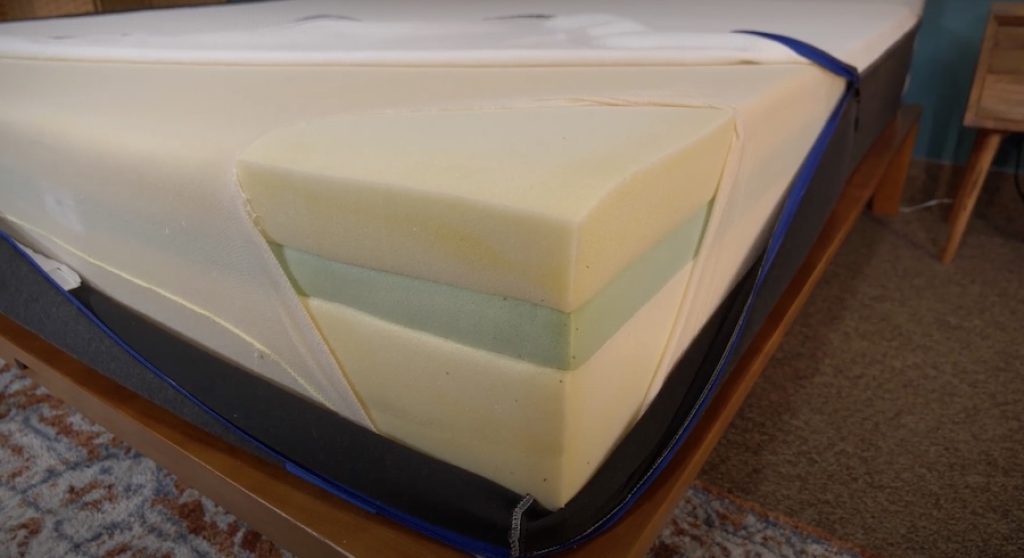
- Layer 4 – ActiveSupport Base Foam (7 inches). The foundation of the mattress, this dense foam keeps sleepers from sinking too deep and adds to the bed’s overall durability.
- Layer 5 – Lower Cover. A stitched lower cover keeps all of the above layers aligned.
My Take: There are people for whom the Nectar won’t be a good fit, namely plus-size folks, stomach sleepers, and people who sleep exceptionally hot. But for anyone who’s not in those categories, this is one of the best memory foam beds on the market—and it’s hard to beat its price.
What I Liked
- Doesn’t forget about support – The Nectar is a memory foam bed first and foremost, so it has a lovely bit of give to it. But at the same time, it doesn’t neglect spinal alignment. Low-quality memory foam beds are all sink and no support, but the Nectar avoids that pitfall.
- A+ policies – In addition to an affordable price, the Nectar boasts some noteworthy policies, including free shipping, a lifetime warranty, and a year-long sleep trial.
Potential Drawbacks
- Not as cool as it claims – The cooling materials in the Nectar didn’t make much of an impression on me during testing. I didn’t overheat, but I didn’t really cool down, either.
- Some people will need a stronger base – Stomach sleepers and heavy people probably won’t get the support they need from the Nectar. Trust me, I’m bitter about this too—I’m a stomach sleeper who loves a good deal!
Customer Reviews of the Nectar Mattress
With thousands of reviews on Nectar’s website, the Nectar mattress has an average 4.8 out of 5 stars. One common customer complaint about the Nectar mattress is its longer-than-average break-in period, while many customers praise its excellent value and comfort once fully settled.
Looking to learn more? Check out our Nectar mattress review or look at our roundup of the best mattresses of 2024.
Nolah Signature – Best Memory Foam Mattress for Side Sleepers
Nolah Signature All-Foam Hybrid Mattress
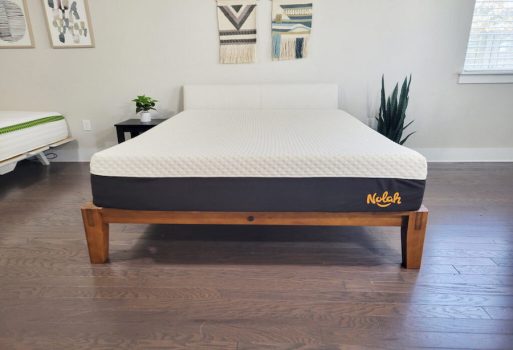
With 75% more cooling AirFoam™ than Nolah Original, the Nolah Signature Foam Hybrid is an excellent option for hot sleepers and side sleepers with pressure build-up.
Material
Foam
Trial Period
120 nights
Shipping Method
Free shipping
Firmness
Medium: 5/10
Warranty
Lifetime warranty
Price Range
$$$$$
We recommend this mattress for the following sleeper types:
Hot Sleepers
If you often overheat while you sleep, this mattress should help you stay cool.Back Sleeping
Ideal for lightweight and average weight back sleepers.Side Sleeping
Ideal for lightweight and average weight side sleepers.Financing Options
Financing options are available for this mattress.
Nolah Signature All-Foam Hybrid Mattress

With 75% more cooling AirFoam™ than Nolah Original, the Nolah Signature Foam Hybrid is an excellent option for hot sleepers and side sleepers with pressure build-up.
Material
Foam
Warranty
Lifetime warranty
Firmness
Medium: 5/10
Shipping Method
Free shipping
Trial Period
120 nights
Price Range
$$$$$
We recommend this mattress for the following sleeper types:
Hot Sleepers
If you often overheat while you sleep, this mattress should help you stay cool.Back Sleeping
Ideal for lightweight and average weight back sleepers.Side Sleeping
Ideal for lightweight and average weight side sleepers.Financing Options
Financing options are available for this mattress.

Nolah Signature All-Foam Hybrid Mattress
With 75% more cooling AirFoam™ than Nolah Original, the Nolah Signature Foam Hybrid is an excellent option for hot sleepers and side sleepers with pressure build-up.
Material
Foam
Firmness
Medium: 5/10
Trial Period
120 nights
Warranty
Lifetime warranty
Shipping Method
Free shipping
Price Range
$$$$$
We recommend this mattress for the following sleeper types:
Hot Sleepers
If you often overheat while you sleep, this mattress should help you stay cool.Back Sleeping
Ideal for lightweight and average weight back sleepers.Side Sleeping
Ideal for lightweight and average weight side sleepers.Financing Options
Financing options are available for this mattress.
Why the Nolah Signature Earned Best Memory Foam Mattress for Side Sleepers
Memory foam has long been the go-to material when it comes to pressure relief, but Nolah claims that their proprietary AirFoam™ blows older versions of memory foam out of the water. According to the brand, AirFoam™ provides up to four times the pressure relief you can get from traditional memory foam—and that adds up to a big difference for people who sleep on their sides.
Several of my team members tested the Nolah Signature to see just how well-suited to side sleepers it was. The results were pretty unanimous, and summed up by my fellow tester Liz: “This mattress is perfect for sleeping on your side.”
What’s the Nolah Signature Made Of?
The Nolah Signature has five total layers and stands 12 inches tall.
- Layer 1 – Organic Cotton Cover. Unbleached, organic cotton makes this cover breathable and soft.
- Layer 2 – Plush AirFoam™ (2.5 inches). Nolah’s proprietary foam is allegedly cooler, more durable, and more pressure-relieving than classic memory foam.
- Layer 3 – Active Response Foam (1.5 inches). This foam has some bounce to it and also permits cooling airflow.
- Layer 4 – Firm AirFoam™ (1 inch). A more robust layer of AirFoam™ than the one at the top of the bed, this one combines pressure relief and support.
- Layer 5 – High-Density Foam Foundation (7 inches). A sturdy foam base helps to boost the bed’s longevity and solidity.
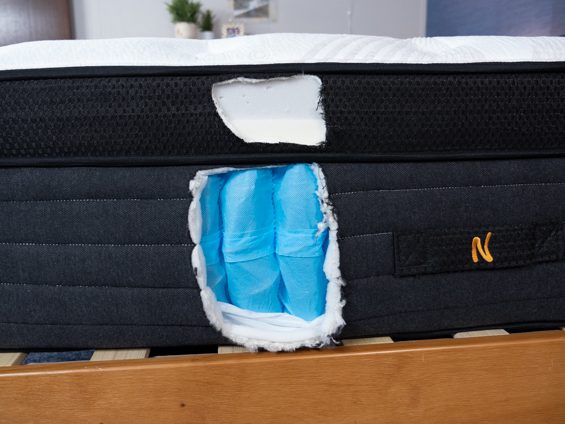
Our Take: “The Nolah Signature is a softer mattress, so it’s going to excel for side sleepers who want pressure relief in their shoulders and hips … When sleeping on my side, I love this bed. It’s like a dream. It’s like memory foam but it has a much cooler feel.” – Emma Mattei, Sleep Advisor Mattress Tester
What We Liked
- A new take on memory foam – AirFoam™ allegedly does everything memory foam can do, only better. “It really hugged those areas that I wanted it to,” said Mark. Emma agreed, adding that it did feel cooler than memory foam, too.
- Little to no motion transfer – “Foam beds are wonderful when it comes to motion transfer, and this Nolah mattress is no exception,” Emma reported. The team clocked virtually no ripples of motion across the bed during testing.
Potential Drawbacks
- Edges aren’t reinforced – Mark was hard-pressed to think of a downside to this bed, but eventually said, “If I could think of anything, it might be that the edge support wasn’t as strong as I would like it to be, as someone who sleeps with a partner.”
- Not for plus-size sleepers – Unfortunately, the Nolah Signature isn’t a good pick for heavyweight folks. Our plus-size tester, Sean, found it comfortable but not quite supportive enough. “I found that I sunk in a bit more when I was sleeping on my back and my side,” he said.
Customer Reviews of the Nolah Signature
The Nolah Signature gets a 4.8 out of 5 stars on Nolah’s website. One potential drawback of the Nolah Signature mattress is its limited firmness options, but it excels in providing exceptional pressure relief and a cooling sleep experience.
Need more info? Read our review of the Nolah Signature bed or look at our roundup of the best mattresses for side sleepers.
Helix Midnight – Best Hybrid Memory Foam Mattress
Helix Midnight Mattress
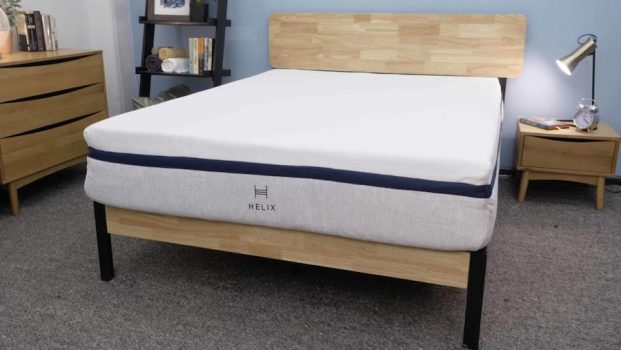
Part of Helix’s core line of mattresses, the Midnight has a hybrid construction that’s particularly suited to back and side sleepers.
Material
Hybrid
Trial Period
100 nights
Shipping Method
Free shipping
Firmness
Medium-firm: 6/10
Warranty
10-year warranty
Price Range
$$$$$
We recommend this mattress for the following sleeper types:
Couples
This bed has great motion isolation so you will not feel your partner tossing and turning at night.Back Sleeping
Ideal for lightweight and average weight back sleepers.Side Sleeping
Ideal for lightweight and average weight side sleepers.Financing Options
Financing options are available for this mattress.
Helix Midnight Mattress

Part of Helix’s core line of mattresses, the Midnight has a hybrid construction that’s particularly suited to back and side sleepers.
Material
Hybrid
Warranty
10-year warranty
Firmness
Medium-firm: 6/10
Shipping Method
Free shipping
Trial Period
100 nights
Price Range
$$$$$
We recommend this mattress for the following sleeper types:
Couples
This bed has great motion isolation so you will not feel your partner tossing and turning at night.Back Sleeping
Ideal for lightweight and average weight back sleepers.Side Sleeping
Ideal for lightweight and average weight side sleepers.Financing Options
Financing options are available for this mattress.

Helix Midnight Mattress
Part of Helix’s core line of mattresses, the Midnight has a hybrid construction that’s particularly suited to back and side sleepers.
Material
Hybrid
Firmness
Medium-firm: 6/10
Trial Period
100 nights
Warranty
10-year warranty
Shipping Method
Free shipping
Price Range
$$$$$
We recommend this mattress for the following sleeper types:
Couples
This bed has great motion isolation so you will not feel your partner tossing and turning at night.Back Sleeping
Ideal for lightweight and average weight back sleepers.Side Sleeping
Ideal for lightweight and average weight side sleepers.Financing Options
Financing options are available for this mattress.
Why the Helix Midnight Earned Best Hybrid Memory Foam Mattress
If you’re a memory-foam fan but don’t want an all-foam bed, you can look for hybrid mattresses that incorporate cushy foam layers above their innerspring units. The Helix Midnight is one such bed (though it calls its proprietary version of the material Memory Plus Foam).
With the Midnight, you’ll get more of an airy, springy feeling than you would from a dense foam bed. “I like how the foams feel soft, but not too soft, like I’m sinking in and getting stuck,” said Emma. She particularly enjoyed the Midnight when lying on her back, because the springs and foams gave the ideal combination of pushback and plushness in this position.
What’s the Helix Midnight Made Of?
The Helix Midnight is 11.5 inches tall and has six layers if you count its top cover.
- Layer 1 – Soft Touch Cover. This fabric cover stretches slightly and feels soft. If you pay an extra fee, you can upgrade it to the GlacioTex™ Cooling Cover.
- Layer 2 – Memory Plus Foam. Helix’s take on memory foam, this proprietary material cushions and conforms to the body.
- Layer 3 – Helix Responsive Foam. A bouncier foam with a medium-firm feel that also molds to your silhouette.
- Layer 4 – Helix Responsive Foam. An even more supportive version of the foam above.
- Layer 5 – Coil Unit. This innerspring unit features pocketed coils that have been reinforced on the long sides of the bed for edge support.
- Layer 6 – DuraDense Foam. A strong foam base.
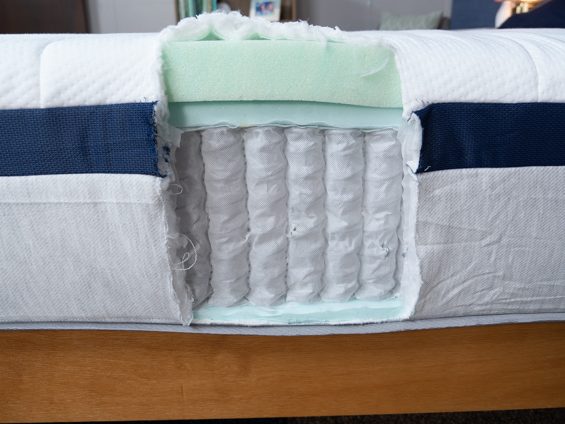
Our Take: “A killer value for the money … The mix of comfort and support is just right. And the medium-soft feel is a great choice if you love to sleep on your back.” – Emma, Sleep Advisor Mattress Tester
What We Liked
- Cooling coils – As a hybrid bed, the Midnight gets a cooling boost from the airflow around its springs. Emma noticed this effect when testing it, and commented that the mattress “feels super cool, thanks to [its] coils.”
- Caters to multiple sleeping positions – Although the Midnight line claims to cater to side sleepers, we’ve found that its mid-range firmness should work well for average-sized back sleepers and lightweight stomach sleepers, too. Emma, a combination sleeper, appreciated how easy it was to switch the way she was lying on the bed: “I can move and adjust positions, no problem.”
- Keeps motion to a minimum – “We were actually really surprised by how well it isolated motion,” said Emma. In her opinion, “most couples will love the Helix Midnight,” thanks to this motion-dampening power and its noticeable edge support.
Potential Drawbacks
- Not firm enough for stomach sleepers – When lying on her stomach, Emma felt her hips sink a little too low for comfort. “I might suggest a firmer mattress for exclusive stomach sleepers,” she concluded.
- Hybrid feel, no foam “hug” – “If you want that old-school memory foam feel, this bed may not be for you,” Emma said. You’ll be boosted atop this mattress rather than deeply cradled within its foam layers.
Customer Reviews of the Helix Midnight
The Helix Midnight rates 4.5 stars out of 5 on Helix’s website. The main negative is that reviewers tend to find it too soft for their liking and feel as though they’re sinking. But overall, users say they’re getting a great nights’ sleep and some pain relief.
Need more info? Read our review of the Helix Midnight or look at our roundup of the best hybrid beds.
Bear Original – Best Firm Memory Foam Mattress
Bear Original Mattress
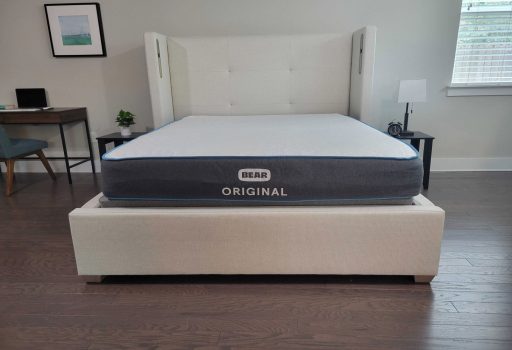
This flagship model was thoughtfully crafted and assembled to be an attractive all-foam option for athletes who need better rest.
Material
Foam
Trial Period
120 nights
Shipping Method
Free shipping
Firmness
Medium-firm: 6.5/10
Warranty
Lifetime warranty
Price Range
$$$$$
We recommend this mattress for the following sleeper types:
Hot Sleepers
If you often overheat while you sleep, this mattress should help you stay cool.Back Sleeping
Ideal for lightweight and average weight back sleepers.Side Sleeping
Ideal for lightweight and average weight side sleepers.Financing Options
Financing options are available for this mattress.
Bear Original Mattress

This flagship model was thoughtfully crafted and assembled to be an attractive all-foam option for athletes who need better rest.
Material
Foam
Warranty
Lifetime warranty
Firmness
Medium-firm: 6.5/10
Shipping Method
Free shipping
Trial Period
120 nights
Price Range
$$$$$
We recommend this mattress for the following sleeper types:
Hot Sleepers
If you often overheat while you sleep, this mattress should help you stay cool.Back Sleeping
Ideal for lightweight and average weight back sleepers.Side Sleeping
Ideal for lightweight and average weight side sleepers.Financing Options
Financing options are available for this mattress.

Bear Original Mattress
This flagship model was thoughtfully crafted and assembled to be an attractive all-foam option for athletes who need better rest.
Material
Foam
Firmness
Medium-firm: 6.5/10
Trial Period
120 nights
Warranty
Lifetime warranty
Shipping Method
Free shipping
Price Range
$$$$$
We recommend this mattress for the following sleeper types:
Hot Sleepers
If you often overheat while you sleep, this mattress should help you stay cool.Back Sleeping
Ideal for lightweight and average weight back sleepers.Side Sleeping
Ideal for lightweight and average weight side sleepers.Financing Options
Financing options are available for this mattress.
Why the Bear Original Earned Best Firm Memory Foam Mattress
Many people think of memory foam as a soft, malleable material that will sink easily beneath your weight. But foams can be made in different densities and with different feels, and a firm memory foam mattress isn’t just possible—it’s often preferable, especially if you sleep on your back or stomach.
In testing the Bear Original, both Mark and Stuart found it to be pleasantly firm. “I did really like this bed when I laid on my back, and when I laid on my stomach. It was firm enough for those two positions,” said Mark. Stuart agreed, adding that “for the average-sized sleeper, this is going to feel like a firm bed. Naturally, a heavier sleeper would experience this bed as softer.”
What’s the Bear Original Mattress Made Of?
The Bear Original has four layers (including its cover) that add up to 10 inches of height.
- Layer 1 – Tencel™ Cover. Tencel™ fibers made from wood pulp make this cover cool and breathable. For an additional fee, you can upgrade to a Celliant®-infused cover that allegedly helps with muscle recovery.
- Layer 2 – Cooling Gel Memory Foam. The gel inside this foam helps to siphon away excess heat, while the foam itself lightly cushions pressure points.
- Layer 3 – Bear Dynamic Foam. A responsive material that marries support with a bit of sink.
- Layer 4 – High-Density Support Foam. A sturdy base for the layers above.
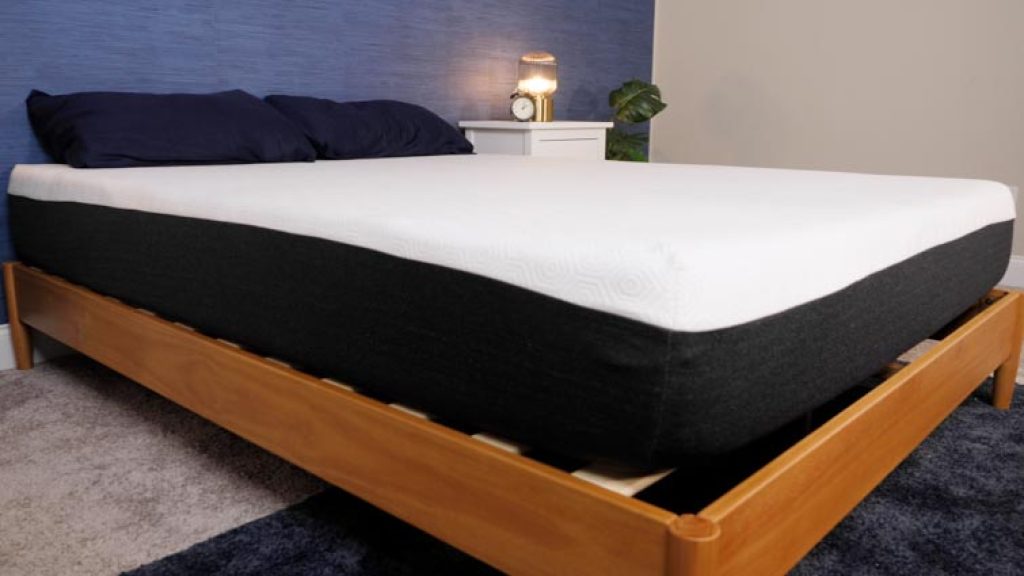
Our Take: “I feel more like I’m laying on the surface of this bed rather than in it … It’s a little firmer than the typical all-foam mattress, which should make it a little bit more versatile for different kinds of sleepers.” – Stuart Petty, Sleep Advisor Mattress Tester
What We Liked
- Option to upgrade to Celliant® – One of Bear’s standout features is their Celliant® covers. On this bed, the cover will tack an additional fee onto your order, but if you’re curious about high-tech textiles, it may be worth it. Reportedly, Celliant® can up blood flow, decrease inflammation, and aid muscle recovery by converting body heat into infrared light.
- Awesome motion isolation – “I’m pretty sure you could do a cannonball into this bed and your partner would be none the wiser,” said Stuart.
Potential Drawbacks
- Not enough cushion for side sleepers – Stuart sleeps on his side often, and that was his least favorite position on the Bear Original: “It feels great on my stomach, decent on my back, and for side-sleeping, I’d prefer something with slightly more sink for my wider shoulders.” Mark agreed, saying, “I was comfortable, but I do think I would have a hard time sleeping on [my side] overnight.”
- Heavy folks may need more support – This mattress is firm, but has a relatively slim profile and not very many layers, which means plus-size sleepers may find themselves feeling uneven or unsupported.
Customer Reviews of the Bear Mattress
According to Bear’s website, the Bear Original scores about 4.5 out of 5 stars. Customers appreciate the Bear Original mattress for its excellent pressure relief but have reported that its edge support may be lacking, which could affect those who use the full mattress surface.
Looking for more info? Read our Bear Original mattress review or look at our roundup for the best firm mattresses.
Emma Original – Best Cheap Memory Foam Mattress
Emma Mattress
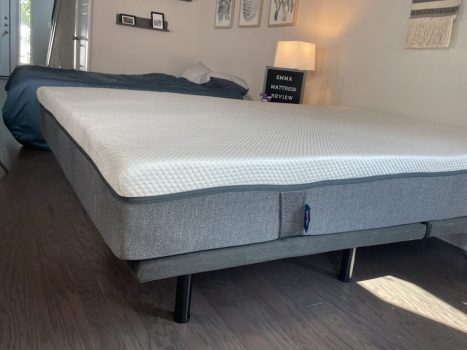
The Emma mattress offers support, cooling, and motion isolation, so it’s a good option for hot sleepers, couples, and those in need of maximum support for healthy sleep posture.
Material
Foam
Trial Period
365 nights
Shipping Method
Free shipping
Firmness
Medium: 5/10
Warranty
10-year warranty
Price Range
$$$$$
We recommend this mattress for the following sleeper types:
Hot Sleepers
If you often overheat while you sleep, this mattress should help you stay cool.Kids
This bed is perfect for young sleepers.Back Sleeping
Ideal for lightweight and average weight back sleepers.Financing Options
Financing options are available for this mattress.
Emma Mattress

The Emma mattress offers support, cooling, and motion isolation, so it’s a good option for hot sleepers, couples, and those in need of maximum support for healthy sleep posture.
Material
Foam
Warranty
10-year warranty
Firmness
Medium: 5/10
Shipping Method
Free shipping
Trial Period
365 nights
Price Range
$$$$$
We recommend this mattress for the following sleeper types:
Hot Sleepers
If you often overheat while you sleep, this mattress should help you stay cool.Kids
This bed is perfect for young sleepers.Back Sleeping
Ideal for lightweight and average weight back sleepers.Financing Options
Financing options are available for this mattress.

Emma Mattress
The Emma mattress offers support, cooling, and motion isolation, so it’s a good option for hot sleepers, couples, and those in need of maximum support for healthy sleep posture.
Material
Foam
Firmness
Medium: 5/10
Trial Period
365 nights
Warranty
10-year warranty
Shipping Method
Free shipping
Price Range
$$$$$
We recommend this mattress for the following sleeper types:
Hot Sleepers
If you often overheat while you sleep, this mattress should help you stay cool.Kids
This bed is perfect for young sleepers.Back Sleeping
Ideal for lightweight and average weight back sleepers.Financing Options
Financing options are available for this mattress.
Why the Emma Original Earned Best Cheap Memory Foam Mattress
Memory foam mattresses tend to be more affordable than other mattress types, but the Emma Original is budget-friendly even when compared to its fellow all-foam beds. The brand often has discounts and sales active as well, driving the price of a queen well below $1,000.
The low cost doesn’t bespeak low quality, however. This mattress incorporates multiple types of foam and even a zoned base, which provides specialized levels of support beneath different areas of the body.
What’s the Emma Original Mattress Made Of?
The Emma Original is 10 inches tall and has four layers, including its top cover.
- Layer 1 – Top Cover. A soft and removable cover that you can throw in the washing machine as needed.
- Layer 2 – Temperature-Regulating Foam. A pillowy and breathable foam that also strives to eradicate sweat.
- Layer 3 – Halo Memory Foam. This layer conforms to the shape of your body and relieves pressure from sensitive joints.
- Layer 4 – HRX Foam. A base layer of HRX (High Resiliency Extra) Foam gives the bed a strong foundation. This layer is also zoned into three regions that deliver different amounts of pushback to accommodate the body’s needs, encouraging proper spine alignment.
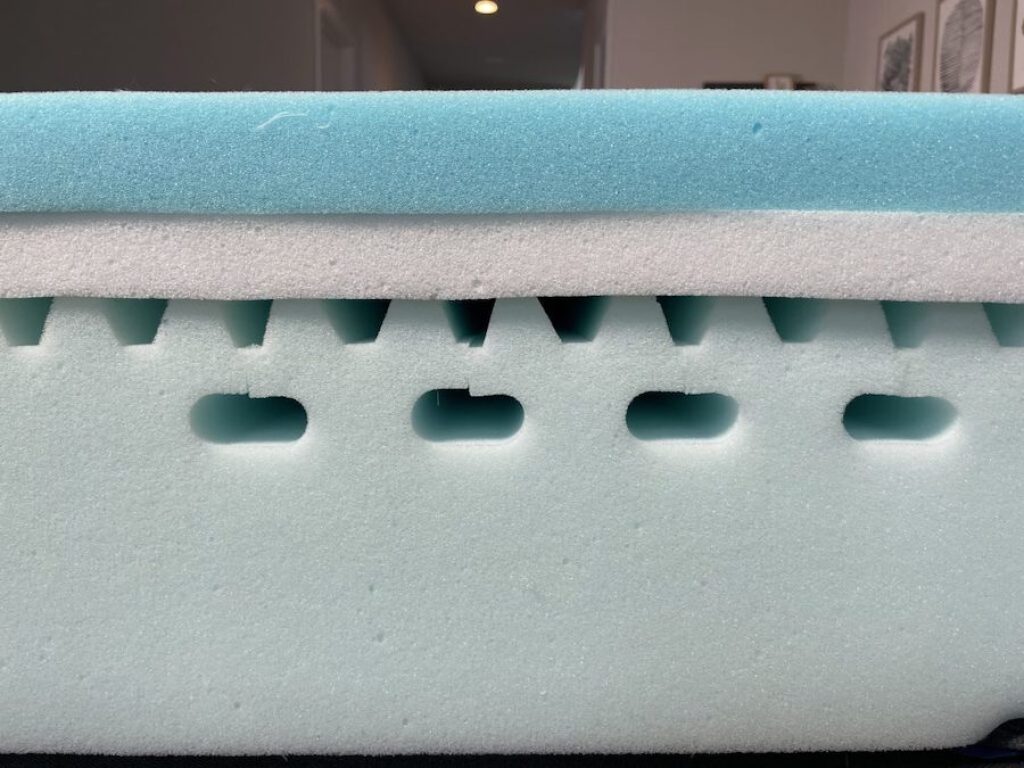
Our Take: We ranked this bed at a 5 out of 10 on our firmness scale, which means it skews soft. It should be a lovely fit for most side sleepers, some back sleepers, and petite folks in particular.
What We Liked
- Plushness and pressure relief – The Emma Original excels at what you’d expect for a memory foam bed: pressure relief and cradling. It should remove tension from stressed joints and swaddle you with a hug-like feel.
- Low motion transfer – The foams in this mattress do a great job of absorbing ripples from movement. Restless sleepers will probably keep their fidgeting to themselves, even when sleeping next to a partner.
Potential Drawbacks
- Not for heavy people – I’d advise heavier sleepers to consider something slightly firmer so that they don’t sink too far into the bed—they could wind up hitting the firm support layers and lose out on pressure relief.
- Weak edges – The edges on this bed aren’t reinforced and may dip when weight is applied. If you sleep all the way against the side of the bed, you may find yourself rolling outwards.
Customer Reviews of the Emma Mattress
According to Emma’s website, the mattress boasts a 4.6-star rating out of 5, with customers lauding its comfort; however, some customers have expressed concerns about its firmness level.
Want to learn more? Visit our Emma mattress review or discover the best cheap mattresses.
GravityLux by WinkBeds – Best Soft Memory Foam Mattress
WinkBeds GravityLux Mattress
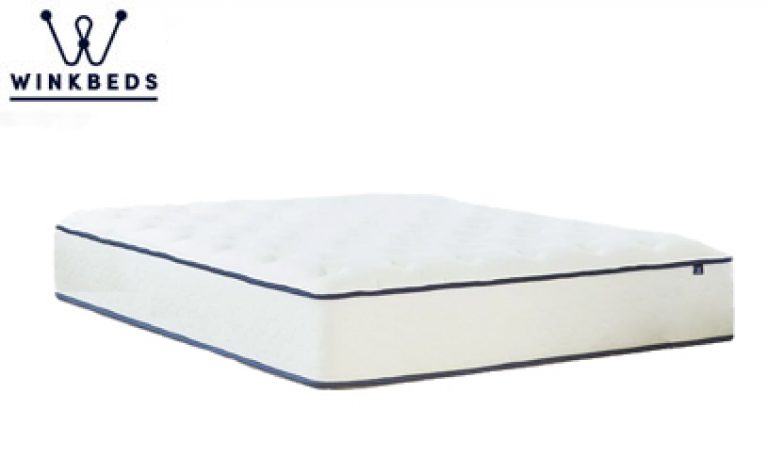
GravityLux introduces a new age of memory foam by fostering a pressure-relieving experience without the drawbacks of traditional viscoelastic materials.
Material
Foam
Trial Period
120 nights
Shipping Method
Free shipping
Firmness
Medium-firm: 6/10
Warranty
Lifetime warranty
Price Range
$$$$$
WinkBeds GravityLux Mattress

GravityLux introduces a new age of memory foam by fostering a pressure-relieving experience without the drawbacks of traditional viscoelastic materials.
Material
Foam
Warranty
Lifetime warranty
Firmness
Medium-firm: 6/10
Shipping Method
Free shipping
Trial Period
120 nights
Price Range
$$$$$

WinkBeds GravityLux Mattress
GravityLux introduces a new age of memory foam by fostering a pressure-relieving experience without the drawbacks of traditional viscoelastic materials.
Material
Foam
Firmness
Medium-firm: 6/10
Trial Period
120 nights
Warranty
Lifetime warranty
Shipping Method
Free shipping
Price Range
$$$$$
Why the GravityLux Earned Best Soft Memory Foam Mattress
The GravityLux comes in three possible firmnesses: Soft, Medium, and Firm. The Soft version should feel pleasingly plush to side and back sleepers, as well as folks who switch between the two positions. Its secret? A proprietary kind of memory foam called AirCell™ Memory Foam, which eschews the traditional viscoelastic materials for a new kind of construction.
According to WinkBeds, AirCell™ Memory Foam consists of microscopic “capsules” of air. These air pockets lend it all the pressure-relieving properties of classic memory foam, but without disadvantages such as heat retention.
What’s the GravityLux Made Of?
The GravityLux is 11 inches high and has four total layers.
- Layer 1 – Tencel™ Cover with Gel-Infused Foam. The breathable cover is quilted with 2 inches of cooling foam for a soft, dry introduction to the bed.
- Layer 2 – AirCell™ Memory Foam. This memory foam consists of microscopic air pockets rather than viscoelastic substances. It still conforms to your body and relieves pressure, while avoiding heat buildup and lasting indentations.
- Layer 3 – Progression Foam™. This foam layer is zoned to provide different amounts of cushioning or pushback depending on the body part above it. It’s plusher beneath the legs and shoulders, but firmer beneath the lower back, for example.
- Layer 4 – ATLAS Core™ Foam. A long-lasting and dense foam base that guards against sag.
Our Take: The GravityLux is a high-tech take on the all-foam mattress, with an alternative type of memory foam and a painstakingly zoned support layer. It’ll cost a bit more than a simpler foam bed, but the perks are likely worth it.
What We Liked
- Lots of zones – The Progression Foam™ layer in this bed takes no less than seven regions of the body into consideration, from your head to your feet. It firms up under your midsection but has more give under the extremities.
- Multiple firmness options – This mattress is pretty customizable, which isn’t always the case for all-foam models. Fans of very soft beds can order the Soft version, whereas people who like to feel a bit more lifted should get the Medium or Firm variant.
Potential Drawbacks
- Not for heavy people – Plus-size sleepers may sink too much into the layers of the GravityLux, and won’t be able to benefit as much from all of its careful support zoning.
- Slow to reform – This isn’t a super responsive mattress, so combo sleepers, restless sleepers, and people with mobility issues may find it tough to move around.
Customer Reviews of the GravityLux Mattress
On the WinkBeds website, the GravityLux scores a 4.8 stars out of 5. Customers appreciate the WinkBed GravityLux mattress for its exceptional support and durability, but some have reported that it may not be as responsive to pressure relief as they expected.
Need more details? Read our in-depth GravityLux bed review or look at our roundup for the best soft mattresses.
Cocoon Chill Memory Foam – Best 10-Inch Memory Foam Mattress
Cocoon Chill Mattress
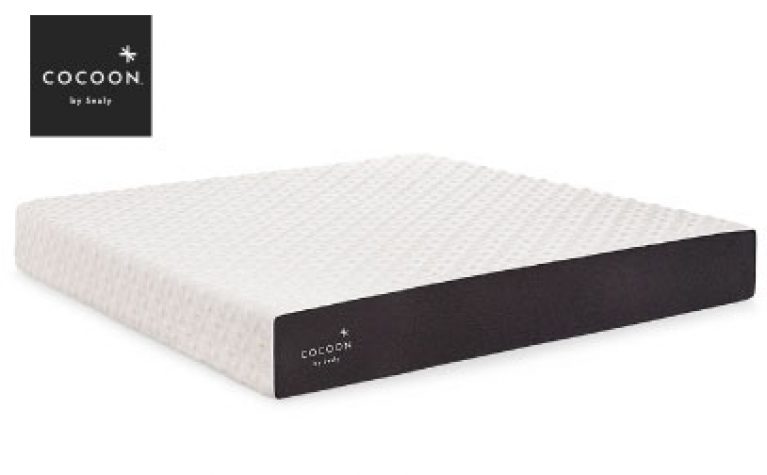
The Cocoon Chill has a 10-inch profile and should fit a range of sleepers thanks to its medium-firm feel.
Material
Foam
Trial Period
100 nights
Shipping Method
Free shipping
Firmness
Medium-firm: 6/10
Warranty
10-year warranty
Price Range
$$$$$
We recommend this mattress for the following sleeper types:
Hot Sleepers
If you often overheat while you sleep, this mattress should help you stay cool.Back Sleeping
Ideal for average weight back sleepers.Side Sleeping
Ideal for lightweight and average weight side sleepers.Financing Options
Financing options are available for this mattress.
Cocoon Chill Mattress

The Cocoon Chill has a 10-inch profile and should fit a range of sleepers thanks to its medium-firm feel.
Material
Foam
Warranty
10-year warranty
Firmness
Medium-firm: 6/10
Shipping Method
Free shipping
Trial Period
100 nights
Price Range
$$$$$
We recommend this mattress for the following sleeper types:
Hot Sleepers
If you often overheat while you sleep, this mattress should help you stay cool.Back Sleeping
Ideal for average weight back sleepers.Side Sleeping
Ideal for lightweight and average weight side sleepers.Financing Options
Financing options are available for this mattress.

Cocoon Chill Mattress
The Cocoon Chill has a 10-inch profile and should fit a range of sleepers thanks to its medium-firm feel.
Material
Foam
Firmness
Medium-firm: 6/10
Trial Period
100 nights
Warranty
10-year warranty
Shipping Method
Free shipping
Price Range
$$$$$
We recommend this mattress for the following sleeper types:
Hot Sleepers
If you often overheat while you sleep, this mattress should help you stay cool.Back Sleeping
Ideal for average weight back sleepers.Side Sleeping
Ideal for lightweight and average weight side sleepers.Financing Options
Financing options are available for this mattress.
Why the Cocoon Chill Earned Best 10-Inch Memory Foam Mattress
If you want a memory foam mattress with a manageable 10-inch height, the Cocoon Chill not only fits the bill—it also boasts some extra-cool features. Its cover, for example, is augmented with phase change material, which helps to carry heat away from your body while ensuring that temperature changes don’t affect the surface of the bed.
It also includes a responsive foam layer beneath its memory foam one, and a more inclusive weight limit than many other foam mattresses.
What’s the Cocoon Chill Mattress Made Of?
The Cocoon Chill is 10 inches tall with a cover and three foam layers.
- Layer 1 – Cooling Cover. Phase change material within the cover helps to channel heat away from you so you don’t wake up sweaty and uncomfortable.
- Layer 2 – Perfect Fit Memory Foam. A breathable kind of memory foam that still molds to your curves to relieve pressure.
- Layer 3 – Responsive Foam. Springier foam that adjusts quickly to your movements and ups the bed’s motion isolation.
- Layer 4 – Support Foam. A 6-inch base of dense, supportive memory foam.
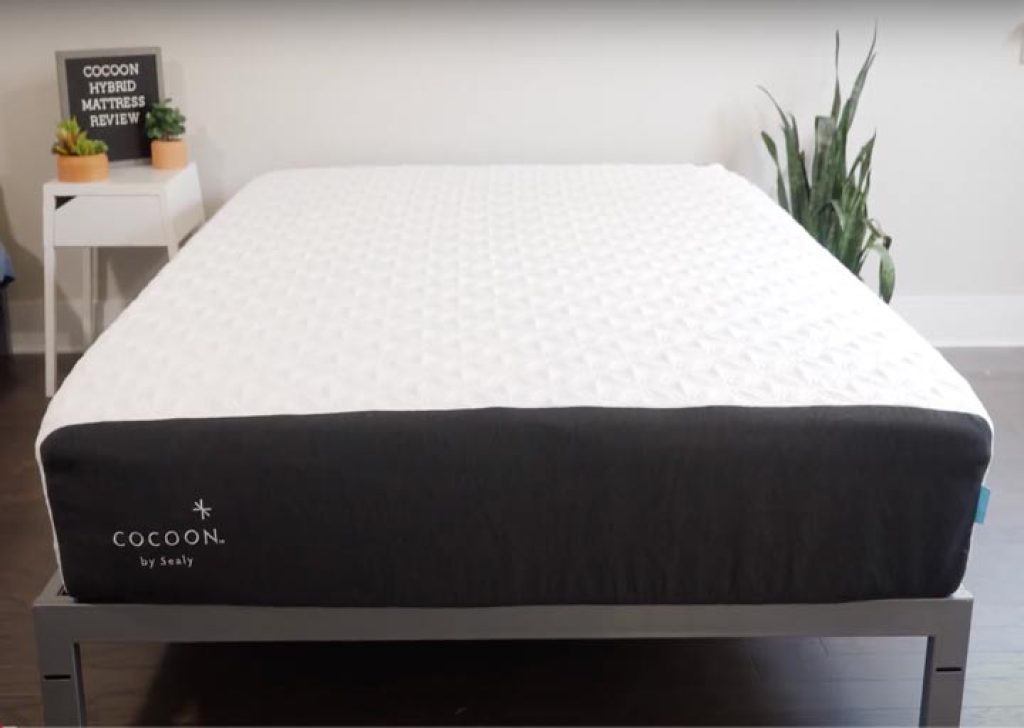
Our Take: The Cocoon Chill has a medium firmness that makes it pretty versatile, and the phase change material in the cover gives it a cooling edge. It’s a lovely foam mattress with a slim profile and just the right amount of perks.
What We Liked
- You can make it even chillier – For an additional fee, you can order this bed with phase change material in the foam as well as in the cover. For especially hot sleepers who want an all-foam mattress, this may be the way to go.
- Decent weight capacity – The Cocoon Chill can handle up to 500 pounds total, or 250 pounds on each side. It’s therefore suitable for average-weight couples and some heavier people who sleep alone.
Potential Drawbacks
- Not bouncy – This bed doesn’t have too much springiness to its foams, so people who toss and turn may prefer a more responsive model.
- Not plush enough for some – Side sleepers and petite people who need lots of cushioning around their joints may think the Cocoon Chill feels too firm.
Customer Reviews of the Cocoon Chill
According to Sealy’s website, the Cocoon Chill scored 4.7 stars out of 5. Customers noted that the Chill offes a cool sleep experience; nevertheless, some customers have expressed concerns about its firmness level not meeting their preferences.
Want more details? Read our full Cocoon Chill mattress review or look at our roundup of the best mattresses for a Murphy bed, all of which have a similarly low profile.
Nectar Premier Copper – Best Cooling Memory Foam Mattress
Nectar Premier Copper Mattress
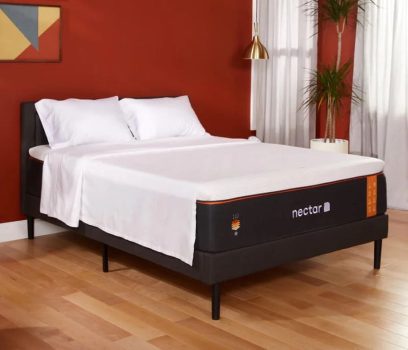
The Nectar Premier Copper mattress delivers a fantastic ratio of softness, support, and pressure relief thanks to its foam layers and cooling technologies.
Material
Foam
Trial Period
365 nights
Shipping Method
Free shipping
Firmness
Medium: 5/10
Warranty
Lifetime warranty
Price Range
$$$$$
We recommend this mattress for the following sleeper types:
Hot Sleepers
If you often overheat while you sleep, this mattress should help you stay cool.Back Sleeping
Ideal for lightweight and average weight back sleepers.Side Sleeping
Ideal for lightweight and average weight side sleepers.Financing Options
Financing options are available for this mattress.
Nectar Premier Copper Mattress

The Nectar Premier Copper mattress delivers a fantastic ratio of softness, support, and pressure relief thanks to its foam layers and cooling technologies.
Material
Foam
Warranty
Lifetime warranty
Firmness
Medium: 5/10
Shipping Method
Free shipping
Trial Period
365 nights
Price Range
$$$$$
We recommend this mattress for the following sleeper types:
Hot Sleepers
If you often overheat while you sleep, this mattress should help you stay cool.Back Sleeping
Ideal for lightweight and average weight back sleepers.Side Sleeping
Ideal for lightweight and average weight side sleepers.Financing Options
Financing options are available for this mattress.

Nectar Premier Copper Mattress
The Nectar Premier Copper mattress delivers a fantastic ratio of softness, support, and pressure relief thanks to its foam layers and cooling technologies.
Material
Foam
Firmness
Medium: 5/10
Trial Period
365 nights
Warranty
Lifetime warranty
Shipping Method
Free shipping
Price Range
$$$$$
We recommend this mattress for the following sleeper types:
Hot Sleepers
If you often overheat while you sleep, this mattress should help you stay cool.Back Sleeping
Ideal for lightweight and average weight back sleepers.Side Sleeping
Ideal for lightweight and average weight side sleepers.Financing Options
Financing options are available for this mattress.
Why the Nectar Premier Copper Earned Best Cooling Memory Foam Mattress
While there’s a lot to love about memory foam, one of the drawbacks of this material is its tendency to run hot. Nectar has used its foam expertise to tackle this issue, and created the Nectar Premier Copper with no less than four cooling elements in its first two layers.
Emma described this mattress as having “excellent cooling,” and Mark was also a big fan: “Out of all the Nectar all-foam [beds] that I’ve tried, this one has to be my favorite,” he said.
What’s the Nectar Premier Copper Made Of?
The Nectar Premier Copper is 14 inches high and has five layers if you count its two covers.
- Layer 1 – Cooling Copper Cover. This cover has the heat-attracting polyethylene fibers that other Nectar models do, but it also boasts copper fibers. A natural heat conductor, the copper draws in and diverts heat so it doesn’t build up around your body.
- Layer 2 – Gel-Infused Memory Foam with ActiveCool (4 inches). This memory foam has cooling gel inside it, as well as ActiveCool phase change material. The latter absorbs heat as you become warmer.
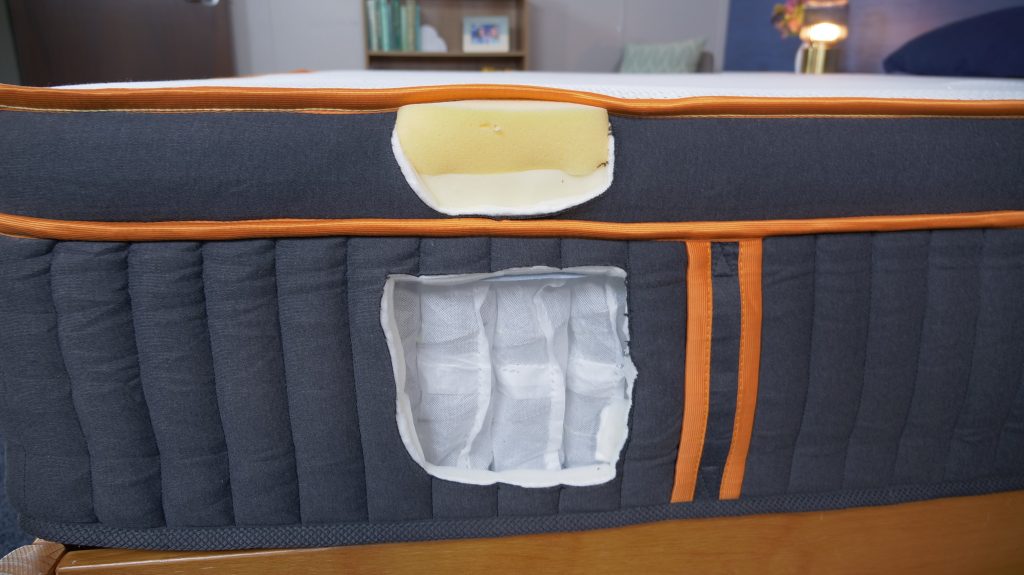
- Layer 3 – Dynamic Response Foam (3 inches). More bouncy than the memory foam above, this layer also permits airflow, dampens movement, and encourages an aligned spine.
- Layer 4 – ActiveSupport Base Foam (7 inches). A strong base that helps with support and durability.
- Layer 5 – Lower Cover. Wrapped around all the internal layers, this cover holds everything together.
Our Take: “Whether you like to sprawl out like a starfish or curl up like a cat, Nectar’s medium-soft firmness should be just right … The coolest-feeling Nectar bed to date.” – Emma, Sleep Advisor Mattress Tester
What We Liked
- Pressure relief is still prominent – All of those cooling add-ons don’t disrupt the snuggly feel of this bed’s foams. It “cuddles every curve and joint,” according to Emma.
- Motion transfer is at a minimum – A full 14 inches of foam really help to cut down on movement traveling across the bed. “You can do a little happy dance without disturbing your partner while they sleep,” Emma commented.
Potential Drawbacks
- A pricier Nectar model – “For an all-foam bed, this isn’t what we would call a budget-friendly mattress,” Emma warned. Without a deal, expect to pay more than $1,500 for this cooling powerhouse.
- Edges aren’t super solid – Though couples should appreciate the low motion transfer, they may not be able to sleep right up on the sides of the bed. “Because the mattress is made entirely of foam, it may not have the most supportive edges,” Emma said.
Customer Reviews of the Nectar Premier Copper
According to Nectar’s site, the Nectar Premier Copper has a rating of 4.7 out of 5 stars. Customers find the Nectar Premier Copper mattress comfortable and supportive, but some have noted that it may have an initial off-gassing odor when unpacked.
Want to know more? Visit our Nectar Premier Copper review or explore our picks for the best cooling mattresses.
Plank Firm – Best Memory Foam Mattress for a Heavy Person
Brooklyn Bedding Plank Firm Mattress
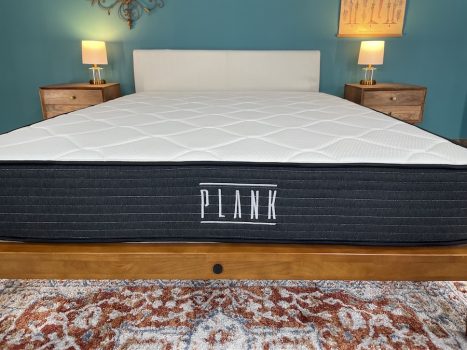
Those in the market for a Firm bed now have a dual-sided choice to see what they require to sleep well-supported and comfortable in Plank Firm, a new product from Brooklyn Bedding.
Material
Foam
Trial Period
120 nights
Shipping Method
Free shipping
Firmness
Multiple firmness options
Warranty
10-year warranty
Price Range
$$$$$
Brooklyn Bedding Plank Firm Mattress

Those in the market for a Firm bed now have a dual-sided choice to see what they require to sleep well-supported and comfortable in Plank Firm, a new product from Brooklyn Bedding.
Material
Foam
Warranty
10-year warranty
Firmness
Multiple firmness options
Shipping Method
Free shipping
Trial Period
120 nights
Price Range
$$$$$

Brooklyn Bedding Plank Firm Mattress
Those in the market for a Firm bed now have a dual-sided choice to see what they require to sleep well-supported and comfortable in Plank Firm, a new product from Brooklyn Bedding.
Material
Foam
Firmness
Multiple firmness options
Trial Period
120 nights
Warranty
10-year warranty
Shipping Method
Free shipping
Price Range
$$$$$
Why the Plank Firm Earned Best Memory Foam Mattress for a Heavy Person
If you’re a large person, an ultra-soft memory foam mattress isn’t your best bet. You’ll want to scope out a bed that’s firm enough to keep your entire body supported while resisting long-term wear and sagging.
Enter the Plank Firm. This bed was inspired by the mat-like sleeping surfaces found in multiple regions of Asia, and it’s an affordable way to obtain the robust support that plus-sized sleepers need. It’s flippable, too, so you’re able to access two firmness levels instead of one. It doesn’t use traditional memory foam, but has an all-foam construction nonetheless, with a weight capacity of up to 950 pounds.
What’s the Plank Firm Made Of?
The Plank Firm is 10.25 inches tall and has four total layers. Because it’s flippable, you can treat either side as the “top” one.
- Layer 1 – Quilted Top (1.5 inches). On the Firm side, the quilted top has a bit more loft to it for slightly more give.
- Layer 2 – TitanFlex™ Foam (2 inches). This TitanFlex™ foam layer should be palpably responsive as well as capable of relieving pressure. It’s only found on the “Firm” side of the mattress.
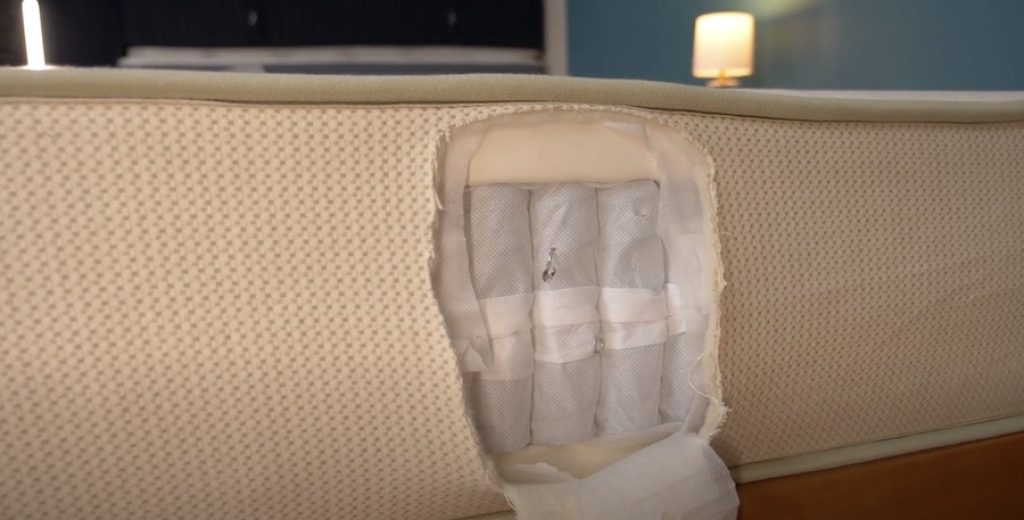
- Layer 3 – High-Density Foam Core (6 inches). A very firm-feeling and supportive core gives the bed the majority of its structure.
- Layer 4 – Quilted Top (0.75 inches). On the Extra Firm side, there’s a 0.75-inch quilted top that feels perfectly level, without much cushion at all.
Our Take: “Changing your comfort setting is as easy as flipping over your mattress … [and] you’re getting a firm, flat sleep experience designed to enhance your sleep health.” – Stuart, Sleep Advisor Mattress Tester
What We Liked
- For firmness fans – Many mattresses say that they’re firm, but don’t quite deliver on the promise. The Plank Firm is different—having lied on it myself, I can testify that it’s one of the firmest mattresses available.
- Flippable design – A Firm side and an Extra Firm side mean that you don’t have to commit to just one feel for your bed. Simply flip it over if you need a change of pace.
Potential Drawbacks
- Supports heavy folks, but not as much as some other beds – I recommend this bed for heavy people, but if you’re sharing with a partner and you both weigh more than 300 pounds, you may enjoy Brooklyn Bedding’s Titan line of mattresses more.
- No cooling mechanisms – This bed was built for firmness first and foremost, so it doesn’t have components geared toward cooling and airflow.
Customer Reviews of the Plank Firm Mattress
On Plank’s website, the Plank Firm gets 4.8 out of 5 stars. Customers appreciate the Brooklyn Bedding Plank Firm mattress for its exceptional firmness, but some have found it to be too rigid for their comfort preferences.
Need more details? Read our in-depth Plank Firm mattress review or explore our picks for the best mattresses for heavy people.
Loom & Leaf – Best Memory Foam Mattress for Back Pain
Loom & Leaf Mattress
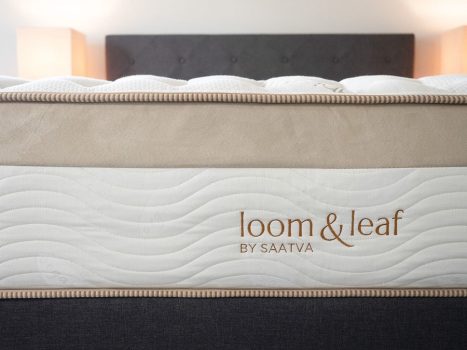
Material
Foam
Trial Period
365 nights
Shipping Method
Free shipping
Firmness
Multiple firmness options
Warranty
Lifetime warranty
Price Range
$$$$$
Loom & Leaf Mattress

Material
Foam
Warranty
Lifetime warranty
Firmness
Multiple firmness options
Shipping Method
Free shipping
Trial Period
365 nights
Price Range
$$$$$

Loom & Leaf Mattress
Material
Foam
Firmness
Multiple firmness options
Trial Period
365 nights
Warranty
Lifetime warranty
Shipping Method
Free shipping
Price Range
$$$$$
Why the Loom & Leaf Earned Best Memory Foam Mattress for Back Pain
Not many memory foam mattresses has as many layers or features as the Loom & Leaf. This bed hones in on the lumbar spine with a “crown” of memory foam just below its cover, bringing some added lift to this sensitive region. According to Stuart, this crown “provides a little extra support and firmness in the middle”—a big benefit, if you’re dealing with back pain.
Overall, Stuart felt very well-supported by the bed when on his back, and enjoyed how it kept him elevated while preserving the soft feel of memory foam.
What’s the Loom & Leaf Made Of?
The Loom & Leaf has a 12-inch profile and six layers. You can order it in a “Relaxed Firm” or “Firm” feel.
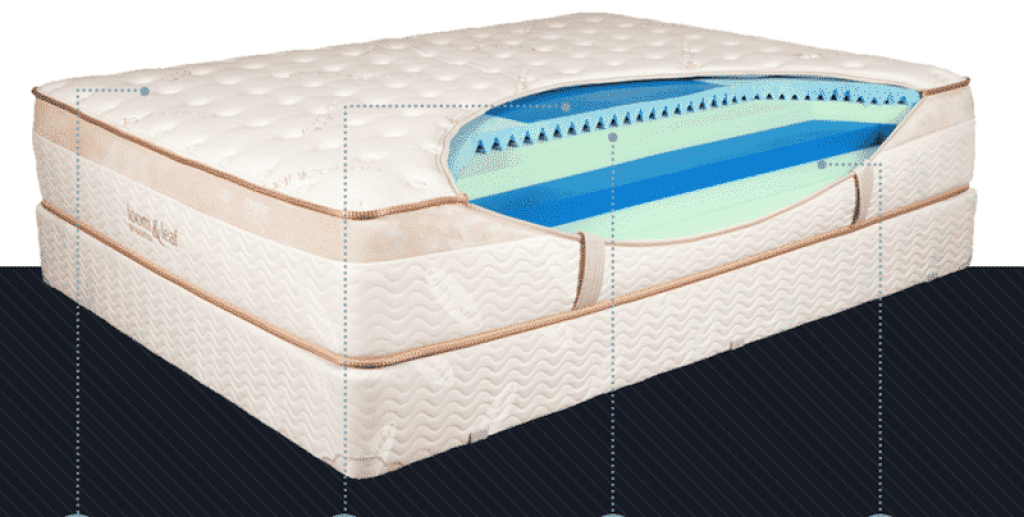
- Layer 1 – Cover. A cover made of organic cotton helps the surface of the bed to breathe, while special quilting beneath the lower back supports your lumbar spine.
- Layer 2 – Memory Foam Lumbar Crown. An isolated strip of memory foam beneath the lumbar region for added support and gel infusions for cooling.
- Layer 3 – Gel-Infused Memory Foam (2 inches). Perforations throughout this layer enable airflow while the memory foam conforms to your body.
- Layer 4 – High-Density Memory Foam Core (2.5 inches). A more supportive version of memory foam provides a secure, hug-like feeling.
- Layer 5 – Transitional Foam (2 inches). This layer affects the overall firmness of the mattress, depending on the feel you select when ordering: Relaxed Firm or Firm.
- Layer 6 – Foam Base (5.5 inches). A stable foam foundation.
Our Take: “Loom & Leaf is soft and luxurious, but doesn’t sacrifice any support. If you’re looking for a memory foam bed that keeps you more cradled to the surface, you should love this brand.” – Stuart, Sleep Advisor Mattress Tester
What We Liked
- Surprisingly earth-friendly – While memory foam beds aren’t generally known for their eco-friendly design, Saatva has managed to add more than a few green features the Loom & Leaf mattress. It has a GOTS-certified organic cotton cover, a natural flame-retardant barrier, and soybean and corn oils inside its foams.
- Hammock-like cradle – Stuart really liked how the tight upper cover on this bed kept him buoyed, almost like he was in a hammock. “More traditional materials can leave you stuck in the mud, but a combination of features here, including the cover, work to keep you cradled near the top and keep it simple to navigate,” he reported.
Potential Drawbacks
- Not budget-friendly – Saatva makes luxurious mattresses, and this all-foam offering is no exception. It will probably cost a bit more than other foam beds you encounter online.
- Not designed for heavy folks – Plus-size sleepers may sink a bit too deep into this bed’s layers. Stomach sleepers, too, should be mindful of how low their midsections and hips dip when lying on it.
Customer Reviews of the Loom and Leaf
According to Loom & Leaf’s website, the mattress holds an impressive 4.9-star rating out of 5, with customers commending its luxurious feel; however, some customers have noted that the mattress’s thicker profile may pose challenges with certain bed linens.
Want to do more research? Check out more details on the Loom & Leaf in our Loom & Leaf mattress review or explore the best mattresses for back pain.
Other Memory Foam Mattresses We Tested
While these mattresses didn’t make our list, each of these beds are great fits for memory foam lovers. Check out our featured recommendations below.
What is a Memory Foam Mattress?
A memory foam mattress is a bed with comfort layers made of memory foam. There may be other types of foam present in the mattress, but memory foam is taking center stage. These beds are prized by people who seek palpable pressure relief and the feeling of being gently “hugged” by their sleeping surface.
What Is Memory Foam Made Of?
Memory foam is made of a plastic polymer called polyurethane, plus additional substances. These additives change from manufacturer to manufacturer, but they’re what lends the foam its signature feel and elasticity.
Memory foam is also known as viscoelastic polyurethane foam. The term “viscoelastic” refers to the fact that the foam is both viscous (it resists somewhat when pressure is applied) and elastic (it “bounces back” to its original shape when pressure is removed).
Viscoelastic properties are what make this foam unique — poly foam without viscoelastic properties is not memory foam.
Learn more: How Memory Foam Works
What Does Memory Foam Feel Like?
Many users of memory foam report that it has a unique and recognizable feel. It hugs and contours your body as you compress the mattress, providing exceptional pressure relief and support. It’s particularly helpful for those struggling with aches and pains.
The material will gradually change shape to match the outline of your body, meaning the mattress is essentially customized to your needs each time you lie down. When you get up, the material will regain its original shape, readying itself for the next use.
Another advantageous feature of memory foam is the motion isolation it offers. Motion isolation means there is very little transfer of movement from one area of a mattress to the other. On a bed with good motion isolation, if your partner is tossing and turning in the night, you won’t feel the ripple effects from this movement as much.
Traditional spring mattresses don’t have very good motion isolation, which is one reason why memory foam has become so popular.
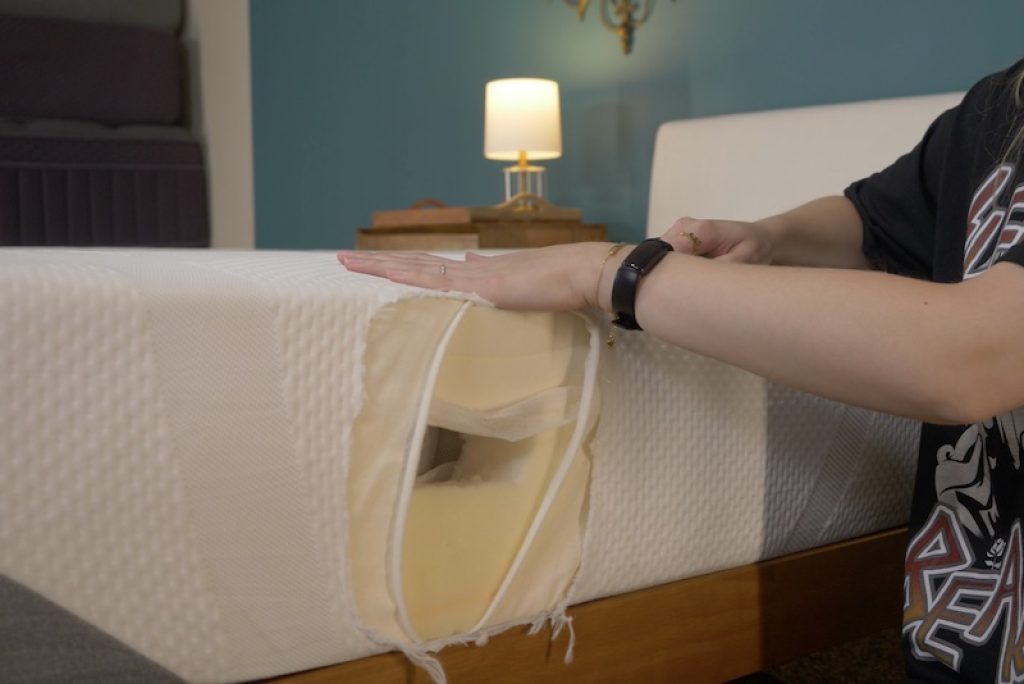
What to Look for in a Memory Foam Mattress
Once you’re ready to start shopping, you’ll need to know what to look for in a memory foam mattress. Some factors are focused on your current status, such as how you sleep or budget limitations, while others are more preference-based.
Memory Foam vs Other Materials
Memory Foam vs Latex
Latex is a material naturally derived from rubber tree sap. It has a bouncier feel than memory foam, which has the tendency to swallow you up, so it could be a good fit for combination sleepers. You can still get pressure relief and cradling from latex, but it may feel a bit firmer. Latex also won’t trap heat as much as memory foam.
Here’s more info on Memory Foam vs Latex
Memory Foam vs Hybrid
A hybrid mattress usually has both memory foam and coils. Coils can give a hybrid bed an edge by providing responsive support while the foams on top offer soft cushioning, so you get the best of both worlds. This combination can work for many, but especially side and back sleepers.
Here’s more info on Memory Foam vs Hybrid
Memory Foam vs Innerspring
Innerspring mattresses are one of the most “classic” mattress types, featuring a (usually interconnected) coil unit and a thin comfort layer. It’s a firmer and springier option when compared to an all-foam bed. This makes it best for those who need sturdy support, like heavier sleepers or those who prefer their stomach.
Here’s more info on Memory Foam vs Spring
Memory Foam vs Pillow Top
A pillow top is a section on top of your mattress that provides extra cushioning with a luxury feel. Sometimes it can contain memory foam, but also a variety of other fills, like fiber or cotton. It differs from memory foam because of its quilted construction that won’t yield the same “hug,” despite feeling sumptuously soft.
Here’s more info on Memory Foam vs Pillow Top
Compare Average Performance Ratings of Mattress Types
| Performance Test | Innerspring | Memory Foam | Hybrid | Latex |
|---|---|---|---|---|
| Pressure Relief | 4 | 4.3 | 4.4 | 3.3 |
| Support | 5 | 4.3 | 4.6 | 4.8 |
| Motion Isolation | 3 | 4.2 | 3.8 | 3.2 |
| Cooling | 4 | 3.7 | 4 | 4.3 |
| Bounce | 4 | 3.6 | 4.2 | 4.8 |
| Edge Support | 5 | 3.5 | 4 | 4.5 |
| Couples | 4 | 3.6 | 3.8 | 4 |
Other Considerations When Shopping for a Memory Foam Mattress
Sleeping Position
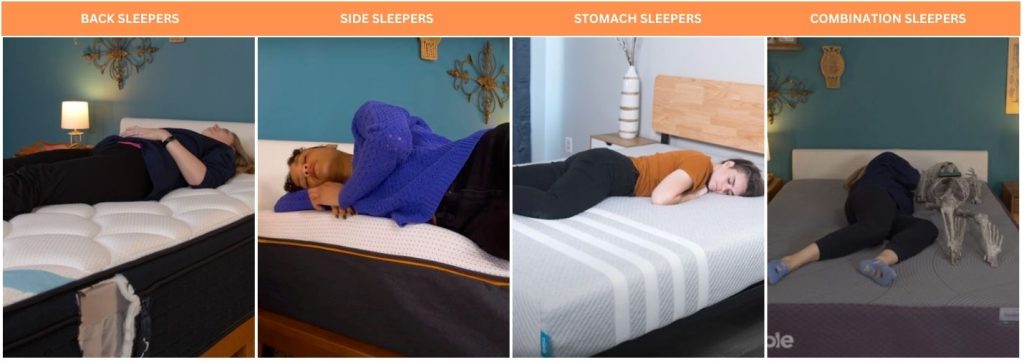
Side sleepers should benefit most from memory foam. Lying on your side can create pressure buildup, particularly in the hips and shoulders. Memory foam does an exceptional job of providing pressure relief, making it fantastic for side sleepers.
The best mattresses for back sleepers are typically made from memory foam, which can relieve pressure from the shoulders. People who rest on their back often need beds that strike a balance between firm support and soft pressure relief.
Stomach sleepers match well with firm memory foam beds. Memory foam can provide a light, initial cushion for a stomach sleeper’s hips, but the focus should be on firm support layers to keep the midsection from dipping too much.
Combination sleepers are least likely to benefit from memory foam because it provides a slow-moving feel as it cradles the sleeper’s shape. Combination sleepers do best with beds that have a bit of bounce to them, such as innerspring or good latex mattresses since these materials make it easier for people to reposition. If you’re a combination sleeper with a heart set on memory foam, a hybrid mattress, which also contains springs, should provide more bounce.
Weight/Body Type of Sleepers
Your body weight will affect how a bed feels and performs because the heavier you are, the deeper you will sink into the layers.
Lightweight sleepers are those weighing 130 pounds or less. These individuals fit well with plush to medium beds, which will help these sleepers avoid feeling like they’re lying on a rock. Sleep position will also need to be considered. If you’re a lightweight side sleeper, you should get a soft mattress, but back or stomach sleepers should get a medium mattress.
Average weight sleepers are between 130 and 230 pounds and make up the majority of shoppers. These individuals need a slightly firmer feel to ensure their body remains in alignment. The best beds for this group have a medium-firm or firm feel, depending on their sleep position.
Heavy sleepers are considered those weighing over 230 pounds. People with significantly larger frames have a higher risk of sinking too far into the mattress, which can feel uncomfortable and throw off body alignment. These shoppers should either purchase a firm mattress or a bed specially designed for plus-size sleepers.
Firmness and Indentation Load Deflection (ILD)
The firmness of memory foam is formally measured on a scale known as indentation load deflection (ILD), which is calculated by measuring the amount of force in pounds it takes for the material to compress. The higher the ILD, the firmer the foam will be. Very soft foams have an ILD of around 20 or less, whereas very firm ones have an ILD above 30.
However, ILD only measures the firmness of the memory foam, not the overall firmness of the mattress. At Sleep Advisor, we also use a general mattress firmness scale of 1-10 (10 being the most firm), based on how the bed feels as you lie on it.
Consider both the ILD of the memory foam and the holistic feel of the mattress as you shop. If you’re someone who likes a very solid foundation of firm support, aim for high numbers in both places.
Density
The density of memory foam is measured in pounds per cubic foot (PCF), and it tells you how tightly packed (vs. airy) the foam is as a material.
Higher-density foams can signal an extremely durable and supportive bed, but they can also mean the bed will retain heat more easily. Look for cooling technology when you’re considering those robust foams.
It’s important to remember that density isn’t the same thing as thickness — a layer of memory foam can be very dense without being impressively thick, and a lightweight foam can be several inches in height.
Memory foam densities are sorted into three ranges:
- Low – 3.5 PCF or below
- Medium – 3.5-5.0 (often considered the ideal range to look for)
- High – 5.0 or above
Cooling
Cooling is a valuable feature for those who easily overheat at night. A mattress with temperature-regulating capabilities will help hot sleepers stay cool, increasing their chances of a good night’s rest.
A common complaint of memory foam is that it retains heat, but many manufacturers offset this by infusing cooling features into the foam. Gel is a popular memory foam cooling mechanism, but some brands have also used copper or an open-cell design. If you sleep hot, look for memory foam beds with cooling properties.
How to Cool a Memory Foam Mattress
- Adjust the Foundation
- Use a Cooling Mattress Topper or Pad
- Cooling Bed Sheets
- Cooling Pillows
Find out more tips on how to cool down your memory foam bed straight from our experts.
Motion Isolation
Motion isolation refers to the bed’s ability to limit the transfer of movement across the mattress. This capability is usually most beneficial for couples who share a mattress and want to avoid disturbing their partner if they toss and turn or have different schedules. Memory foam excels at isolating motion, so if this feature is important to you, these beds are a great match.
Sex
Many couples enjoy memory foam mattresses because they isolate motion well, reducing the chance of one partner waking up the other if they move. However, memory foam is slow-moving with minimal bounce, which some couples who are sexually active may view as a drawback.
Pressure Relief
Memory foam beds can usually be found in the winner’s circle when it comes to pressure relief. This slow-moving material has enhanced elasticity and viscosity that combine with your body heat and weight to gently cradle you. By molding to you, memory foam keeps pressure from building up while you’re sleeping.
Memory foam also generally does a good job of keeping your spine aligned and your hips supported.
These are two key areas when it comes to pressure relief. If your spine is at awkward angles when you sleep or your midsection sags too far into the bed, pressure can build up in your lower back and hips.
Heavyweight sleepers will want to avoid soft and unsupportive memory foam beds because they may push through the comfort layers too quickly, which can cause pressure to escalate.
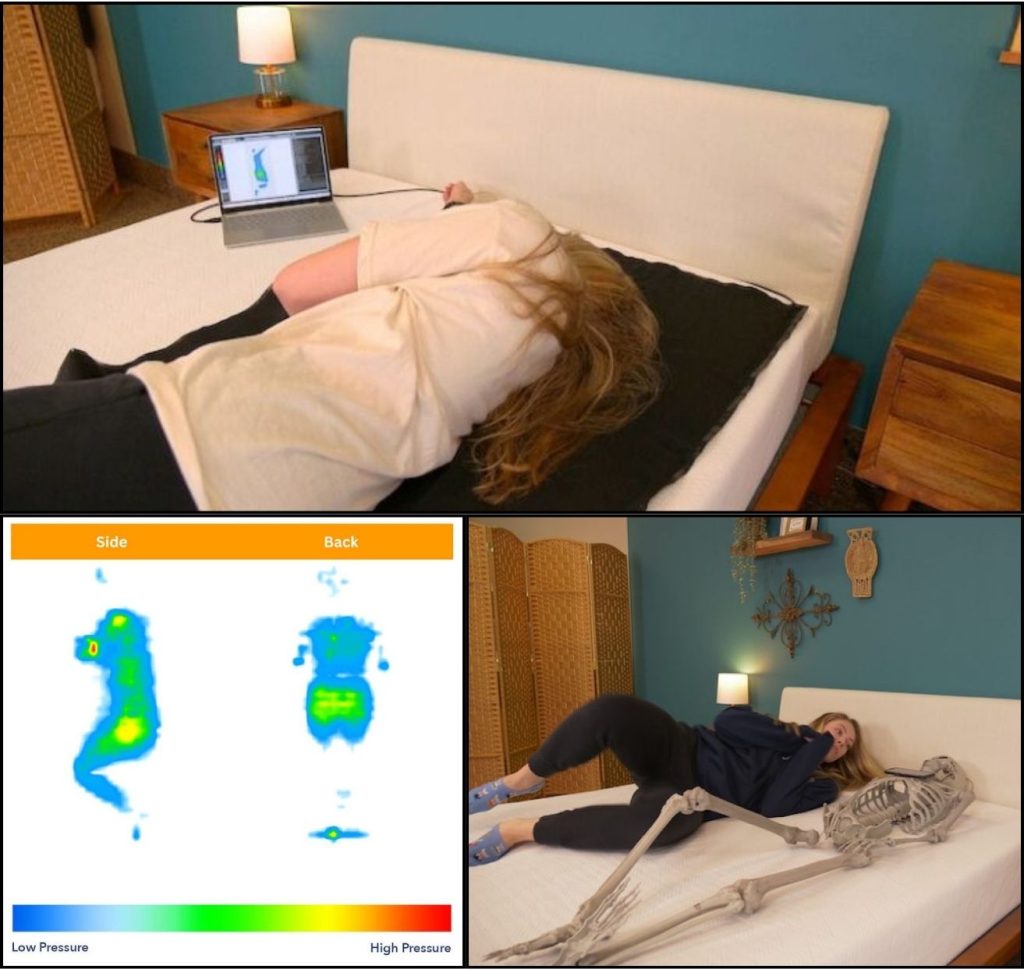
Edge Support
Edge support is something to consider if you want extra surface space use. Mattress edge support means that the bed’s perimeter offers equal support, so you don’t dip much if you lie or sit along the sides. Many mattress brands provide edge support through reinforced materials like strong foam rails.

If you share a bed or usually sit on the edge to put on clothes or shoes, look for brands with proven edge support.
Budget
Memory foam mattresses typically cost more than traditional innerspring mattresses because of the foam’s durability, pressure-relieving properties, motion-isolating capabilities, and strict manufacturing standards. However, they’re a cost-effective option when compared to most hybrid and latex mattresses.
Some brands may enhance their memory foam by incorporating special cooling features or plant-based materials, which can up the price of a bed, but the upgrades to the foam’s quality are often worth the investment. Additionally, online sales models can make quality foam beds more affordable.
For great budget options, see our roundup of the best cheap mattresses.
Best Memory Foam Mattress FAQs
How long will memory foam last?
The lifespan of a memory foam mattress is largely dependent on the quality of materials that are used and how frequently the bed is slept on. Mattresses made with high-end materials and exceptional craftsmanship can be expected to last for approximately seven to 10 years. Conversely, those constructed with less expensive goods may only last three to five years.
Are memory foam mattresses good?
Yes, memory foam mattresses offer a host of benefits. They can deliver contouring pressure relief to help soothe aches and pains. Furthermore, these types of beds tend to excel at motion isolation, which is great for people who share a bed with a restless co-sleeper.
Memory foam isn’t known for its cooling prowess, but many manufacturers have taken note of this and have implemented cooling properties such as gel-infused foam and aeration. However, sexually active couples may find that they feel stuck when trying to reposition during sex on these beds.
Is a memory foam mattress good for your back?
A memory foam mattress can be good for your back because the material’s contouring abilities allow it to relieve pressure in the shoulders for optimal comfort. However, the mattress firmness must be supportive enough to ensure good spine alignment at the same time. If a memory foam bed cradles the sleeper so much that they sink too far, this could lead to poor alignment and back pain.
Typically, medium-firm to firm memory foam mattresses are best for back sleepers, providing just enough pressure relief without sacrificing support.
How long does a memory foam mattress take to expand?
Memory foam beds typically expand to their full capacity within 24-72 hours. However, you will notice that the bed begins to expand to the majority of its size within the first few hours. Many brands will advise that you wait 24 hours before sleeping on the bed to allow it enough time to expand. Waiting to sleep on your new mattress could also help if you’re sensitive to off-gassing, allowing the bed to air out without sheets and blankets over it.
Should I buy a memory foam mattress online?
Buying a memory foam mattress online can save you money without diminishing the quality of the bed you receive. By bypassing middlemen in the traditional supply chain, online mattress companies are able to offer the same caliber of mattresses you’d see in a brick-and-mortar store for much less.
You might be nervous about purchasing a memory foam mattress without testing it. However, most online brands offer generous sleep trials and will refund your money if their product isn’t a perfect fit.
| Mattress | Best For | Price (Queen Size) | Review |
| Nectar | Editor’s Pick | $999 | Nectar Mattress Review |
| Nolah Signature | Side Sleepers | $1,599 | Nolah Signature Mattress Review |
| Helix Midnight | Hybrid | $1,199 | Helix Midnight Mattress Review |
| Bear Original | Firm | $999 | Bear Original Mattress Review |
| Emma Original | Cheap | $1,399 | Emma Original Mattress Review |
| GravityLux by WinkBeds | Soft | $1,799 | Winkbeds Gravity Lux Mattress Review |
| Cocoon Chill Memory Foam | 10-Inch | $699 | Cocoon Chill Mattress Review |
| Nectar Premier Copper | Cooling | $1,699 | Nectar Premier Copper Mattress Review |
| Plank Firm | Heavy Person | $1,249 | Plank Firm Mattress Review |
| Loom & Leaf | Back Pain | $2,395 | Loom & Leaf Mattress Review |

Julia Forbes
Lead Product Tester
About Author
Julia is the Lead Reviewer at Sleep Advisor, specializing in testing out mattresses and sleep accessories – she’s in the right line of work, because she loves to sleep.
Stomach Sleeper
